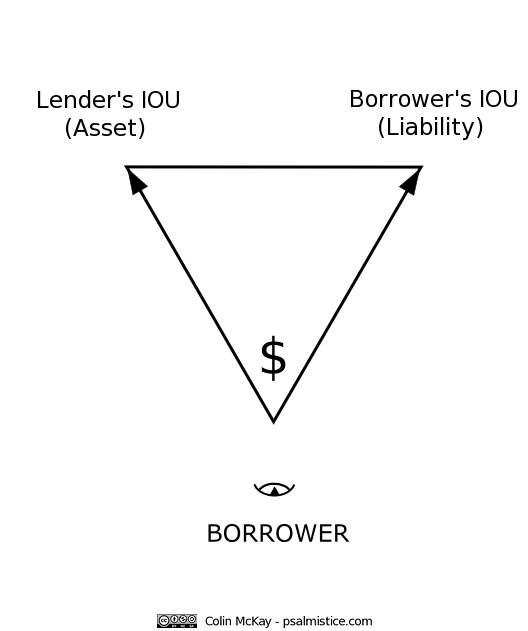Gold on silver
Is the Autumn
Soft and tender
Are her skies
Yes and no
Are the answers
Written in
My true love’s eyes[43]
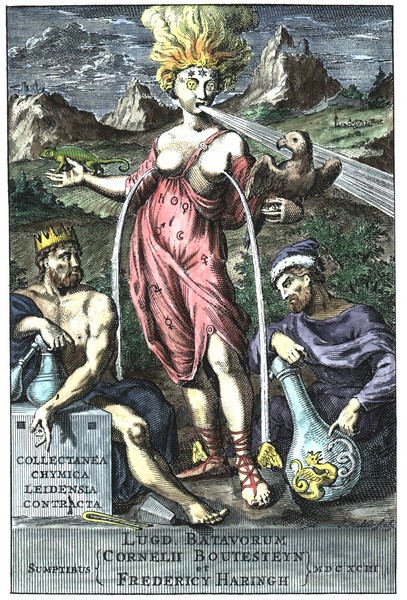
Christopher Love Morley, Collectanea chymica Leidensia contracta, Leiden, 1693. © Adam McLean 1997-2017 (alchemywebsite.com). Used with permission.
[If you have not yet done so, I urge you to read Part 1 of this essay, before continuing with this Part 2.]
To fully understand the base principles of alchemical cheating through the ages – did you see what I did then? – we need to travel back in time, to ancient Mesopotamia.
It is here, in the Fertile Crescent – the Cradle of Civilisation – that archaeologists have uncovered abundant evidence for the earliest recorded origins of two fundamental concepts, or principles, that are still with us today. Together, they are the foundation for fully understanding what George Orwell (1984) described as doublethink – “a vast system of mental cheating”.
These two principles are embedded not only in the monetary art of males cheating females but also in Eastern and Western philosophy, politics, religion, occultism, economics (but I repeat myself), science; indeed, in all realms of human thought, belief, and activity.
The Unity (or Union) of Opposites.
And the Law of Inversion (or reversal).
The Unity of Opposites is an abstract idea – a belief – that all things are created out of the union – the Sacred Marriage – of two equal, “gender” opposites.
A male principle (active, creative, “light”, positive, good).
And a female principle (passive, destructive, “dark”, negative, evil).
This is the exoteric (suitable for the public) principle in alchemy – the manipulated or engineered “transformation” of something, from a “lower” form into a “higher” form.
Like, let’s say, “transforming” a female (evil) into a male (good).
Or, “transforming” your promise to pay the customer real cash (liability), into a record of an unsecured, borrowed from the customer “deposit” (asset).[44]
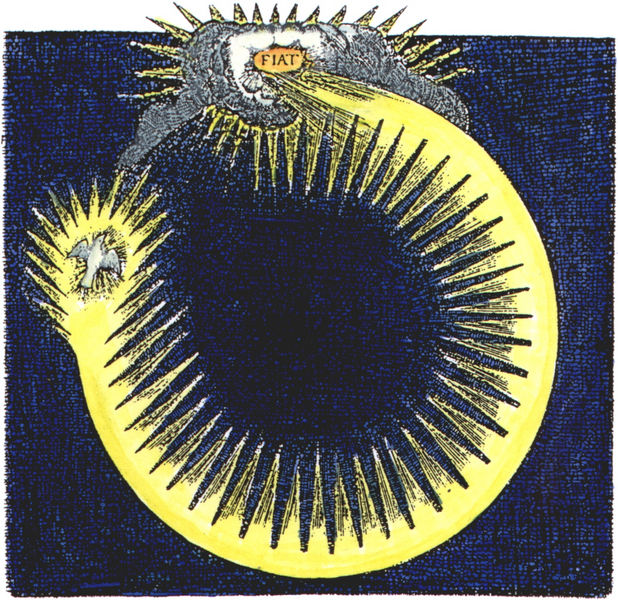
Robert Fludd, Utriusque Cosmi Maioris scilicet et Minoris Metaphysica Physica Atque Technica Historia, 1617-1621. © Adam McLean 1997-2017 (alchemywebsite.com). Used with permission.
As the alchemical principles are believed to be universal, in theory everything can be manipulated and transformed, including minerals (eg, lead into gold), biological matter, ideas, markets, society, and even human consciousness itself.
The only way to do so, however, is by a precise inversion, or reversal, of values.
Lying, and cheating.
In other words, by faking it.
Counterfeiting.
According to Ahmad al-Hassan (Arabic Alchemy ‘Ilm al-San’a: Science of the Art), the Unity of Opposites principle first appears in ancient Babylonia:
The Babylonians believed that the universe originated from water. They noticed also that the universe contains opposite elements. Thus there is day and night; light and darkness; male and female; hot and cold; wet and dry. There is also the good and the evil, and in general, there is for every feature an opposite one. It is also possible to divide matter into two opposite elements, and from these two opposite elements everything can be generated.
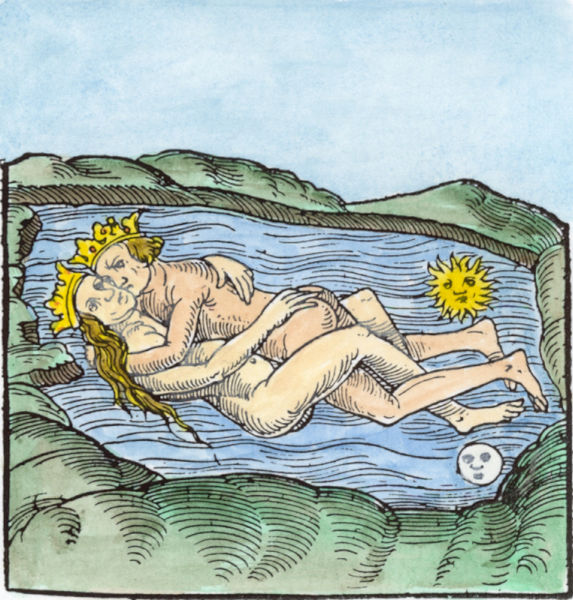
De Alchimia opuscula complura veterum philosophorum (“Rosary of the Philosophers”), Frankfurt, 1550. © Adam McLean 1997-2017 (alchemywebsite.com). Used with permission.
The Babylonians were keen observers of the stars; and from their early history they believed that the gods are in control of the planets. They believed also that the sun, the moon and the other planets [five then known; with sun and moon, seven “gates”] have influence on what happens on earth. This was the beginning of astrology. The influence of the planets involves metals; thus sun influences gold, and the moon influences silver, and the other planets control the remaining metals.

Musaeum hermeticum, Frankfurt 1625. © Adam McLean 1997-2017 (alchemywebsite.com). Used with permission.
The principle of the two opposites of the Babylonians was inherited by Greek philosophers who were thinking about the nature of matter and whose theories were based in part on the Babylonian concept.[45]
The alchemy of the Middle Ages – and the Hermetic Reformation (Renaissance, french “rebirth”), and the 18th century Enlightenment – was built on this Babylonian belief in a cosmic, sexual duality:
[T]he alchemic world view was, just like that of Tantrism, dominated by the idea that our universe functions as the creation and interplay of a masculine and a feminine principle and that all levels of existence are interpenetrated by the polarity of the sexes. “Gender is in everything, everything has masculine and feminine principles, gender reveals itself on all levels”, we can read in a European treatise on the “great art”.[46]
This is also the origin of the Duality Principle in medieval and ‘modern’ bookkeeping by double entry. The Duality Principle is really just the Babylonians’ Unity of Opposites by another name:
For every debit there must be a credit, and for every credit there must be a debit – Alas! How few consider that if this must be the case, the rule to go by, nothing is more easy than to make a set of books wear the appearance of correctness, which at the same time is full of errors, or of false entries, made on purpose to deceive![47]
According to the Jewish Encyclopedia (1906):
The whole dualistic system of good and of evil powers, which goes back to Zoroastrianism and ultimately to old Chaldea, can be traced through Gnosticism; having influenced the cosmology of the ancient Cabala before it reached the medieval one. So is the conception underlying the cabalistic tree, of the right side being the source of light and purity, and the left the source of darkness and impurity [..] The fact also that the “Ḳelippot” (the scalings of impurity), which are so prominent in the medieval Cabala, are found in the old Babylonian incantations [..] is evidence in favor of the antiquity of most of the cabalistic material.

Joseph ben Abraham Gikatilla, Portae Lucis (Latin translation of Gikatilla’s work Shaarei Ora – “Gates of Light”), 1516. © Adam McLean 1997-2017 (alchemywebsite.com). Used with permission.
It stands to reason that the secrets of the theurgic [from Latin theūrgia: “magic”] Cabala are not lightly divulged; and yet the Testament of Solomon recently brought to light the whole system of conjuration of angels and demons, by which the evil spirits were exorcised; even the magic sign or seal of King Solomon, known to the medieval Jew as the Magen Dawid [✡], has been resurrected.[48]

Tree of dark and light from Valentine Weigel, Studium Universale, 1695. © Adam McLean 1997-2017 (alchemywebsite.com). Used with permission.
The prehistoric clay token/envelope record-keeping system of the Fertile Crescent is the earliest evidence for the Unity of Opposites.
Accounting scholars call it the Input-Output principle; a dualistic, abstract re-presentation of real economic exchanges. Like, let’s say, a transfer of “seed” from a male (Output) to a female (Input) … or vice versa:
[The] ancient people of the Middle East had record keeping systems, the basic logical structure of which was virtually identical to that of modern double entry.[49]
[T]he token-accounting of the ancient Middle East, as well as modern accounting, deal with two distinct but related duality aspects. The first kind of duality involves concrete transactions and belongs to physical reality, while the second kind of duality arises out of ownership and debt relations which belong to social reality.
[The] inconspicuous impressing of the clay tokens upon the surface of the receptacle [..] [was] the precursor of modern double entry bookkeeping; more importantly, it was the major impetus to cuneiform writing as well as abstract counting.[50]
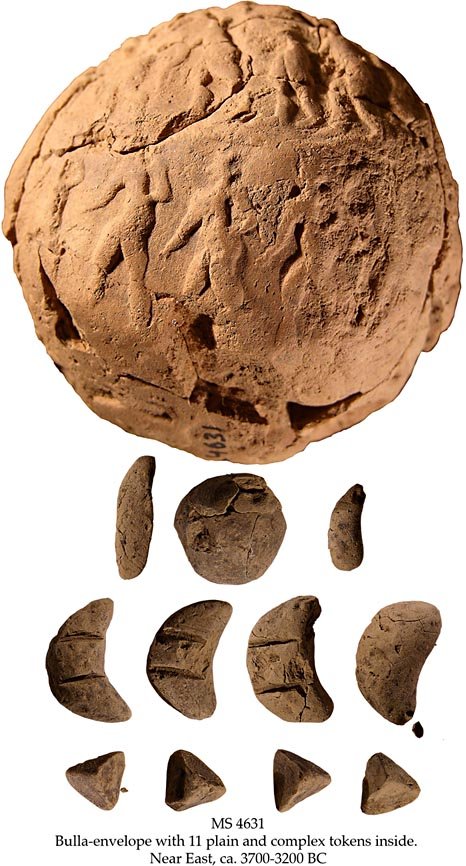
Bulla-envelope with 11 plain and complex tokens inside, representing an account or agreement, tentatively of wages for 4 days’ work, 4 measures of metal, 1 large measure of barley and 2 small measures of some other commodity. (Source: The Schoyen Collection)
Cuneiform (Latin cuneus: “wedge”) writing was created by making impressions on a wet clay tablet with a stylus made from a reed (Sumerian gi-dub(-ba), Akkadian qan-tuppi; literally “tablet reed”), with its tip cut into a triangular wedge.

As cuneiform clay tablet writing gradually replaced token/envelope record-keeping, naturally there was a need to continue recording this double duality.
The mutual obligations of a Sacred Marriage – a mutual exchange of promises to pay – involves two different identities (a male and a female), and eight recordable actions in total when the promises are both honoured.
The promises to pay and repay “seed” – an abstract Ownership-Debt exchange – is one inverse pair of Output-Inputs (4).
The actual payment and repayment of the “seed” – a real exchange – is another inverse pair of Output-Inputs (8).
But when considered from only one perspective (the male’s), there are two identities, and only four recorded actions.
The abstract Output of the (male) promise (his liability), and the abstract Input of the (female) promise (his asset).
Then, on the honey-moon, the real Output of the promised (male) “seed” (his expense, cancelling his liability), and 9 months later again, the real Input of the promised (female) repayment of the “seed” (his income, cancelling her liability/his asset).
All “square”.
This was now reflected in the number of sides the ancient scribe needed to record different kinds of transactions:
Four-sided tablets were utilized for financial transactions and two-sided clay tablets were reserved for agricultural records.[51]

“Aurum Aura” (Air of Gold); Christian Adolf Balduin, Aureum superius et inferius aurae superioris et inferioris Hermeticum, Amsterdam, 1675. © Adam McLean 1997-2017 (alchemywebsite.com). Used with permission.
Early proto-cuneiform (pictogram) writing was steadily refined, and by 3000 BC scribes were able to convey word-concepts (honour), not just word-signs (an honourable man).[52]
By 2600 BC, it was also possible to isolate the phonetic (sound) value of a certain sign. This is known as the rebus principle (Latin rēbus “by means of objects”) – using existing symbols just for their sound, to represent or allude to other words or abstract concepts. It became a favourite form of expression in heraldry of the medieval era – the rebus of Bishop Walter Lyhart of Norwich, for example, consisted of a stag (or hart) lying down.[53]
Ancient scribes – an elite class, thanks to their special knowledge – could now record their puns – “magic” words, that minds inclined to double entendres, deception, or secrecy, purposed to carry double or multiple meanings.
Indeed, scholars believe that cuneiform writing, hieroglyphs, and alphabets, were all based on punning:
The Rebis (from Latin res bina, meaning dual or double matter) is the end product of the alchemical magnum opus or great work.[54]

Heinrich Nollius, Theoria Philosophiae Hermeticae, 1617. © Adam McLean 1997-2017 (alchemywebsite.com). Used with permission.
As we have already seen (Part 1), when stripped bare of all its “authoritative” pretences to mathematical precision, “balance”, and objective impartiality, bookkeeping by double entry is really nothing more than story-telling … with equal positive and negative numbers added.
(Did you see what I did then … for the second time? Loθok again.)
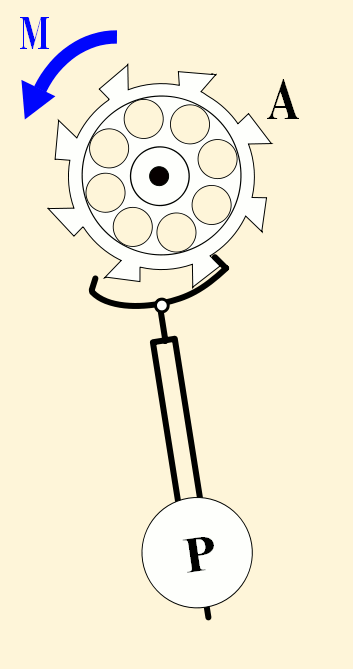
A pendulum-governed escapement of a clock, ticking every second. (Source: Wikipedia)
Most importantly, it is always a story of two (2) opposite perspectives, but it is told from only one perspective – the bookkeeper’s.
By telling his story using puns – words with double or multiple meanings – a cunning bookkeeper can easily deceive any reader or auditor who has not been “initiated” into the occult (hidden, secret) meanings of his code words and symbols:
Legally, [banks] do not take deposits, they borrow from the public. The expressions in banking are designed to mislead what’s really happening.[55]
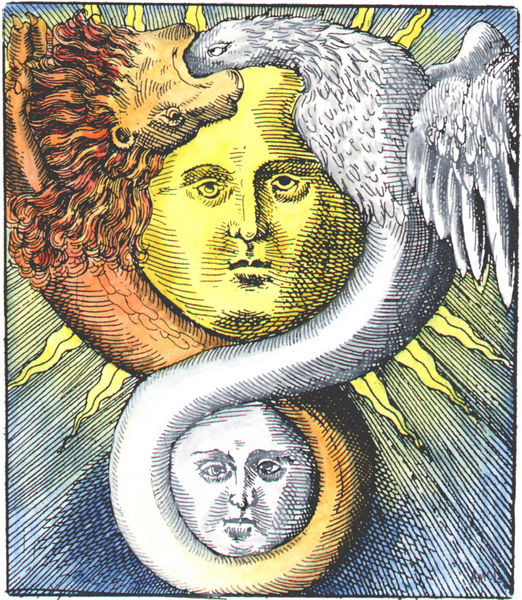
Azoth (from Arabic al-zā’būq: “Mercury”) | Fourth woodcut from Basil Valentine’s Azoth (1613). © Adam McLean 1997-2017 (alchemywebsite.com). Used with permission.
Thoughout the “Dark” and Middle Ages, the practice of usury (lending at “interest”) – a mortal sin – was officially banned by the Church-State authorities. Following the Fourth Lateran Council (1215), it was also mandatory to make a full confession of one’s sins, at least once a year.
For merchants and money-lenders, it was now all the more important to have trading records with code words and symbols “hidden in plain sight”.[56]
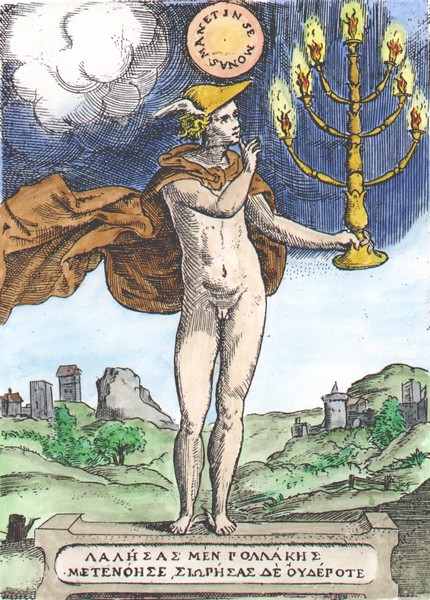
Hermetic silence – Achille Bocchi, Symbolicarum quaestionem de universo genere, 1574. © Adam McLean 1997-2017 (alchemywebsite.com). Used with permission.
Though not as drastic as the penalty imposed by the Babylonian Hammurabi Code No. 7 for issuing fraudulent “deposit” receipts (“that man is a thief: he shall be put to death”), the penalties for practicing usury were still severe.
Not only was there a spiritual threat of the soul’s eternal damnation to the lowest of circles in the seventh circle of hell in the afterlife[57], there was also the ever-present, material threats of social condemnation and ostracisation, physical expulsion from the town, city or state, and of gravest concern for most, asset forfeiture:
Giovanni di Bicci de Medici, founder of the Medici Bank and Cosimo de Medici’s father … died intestate because in making out a will “he would have denounced himself as a usurer and might have caused considerable trouble for his heirs.”[58]
Accounting is a form of story telling – giving an account – and stories require an audience, listeners; auditors. In late medieval Italy, the auditor was God. One historian of accounting, James Aho, argues it’s no coincidence that double entry emerged at a time when confession became compulsory for ordinary Catholics. [..] [K]eeping the fullest possible set of accounts is a bit like confessing your sins. Even if you are doing something morally suspect, at least you are making a clean breast of it.[59][60]
[The “Father of accounting”, Luca] Pacioli [c. 1447-1517] advises merchants to incorporate explicit signs of Christianity into their books as a way of legitimising their profit-seeking activities. The use of double entry itself was like the Catholic confession: if a merchant confessed – or accounted for – all his worldly activities before God, then perhaps his sins would be absolved.[61]
Remarkably, there is a compelling analogue to this in a cuneiform text from the 7th century BC. It comes from the same “fertile” region that had previously birthed the Unity of Opposites principle, punning, primitive record-keeping by double entry, and all the foundational beliefs of alchemy, including – as we will see – the “mystery” cult sex magic rituals, based on the Law of Inversion.
The text is known as the Netherworld Vision or Underworld Vision of an Assyrian Crown Prince, and is the “oldest known visionary journey to hell”[62]:
Scholars have [..] agreed that the text has a great significance for the history of religions and literature. But no one can agree precisely on what that significance is. The text’s interpretation has been hampered by its very distinctiveness: in 2,000 years of cuneiform literature, there are no other examples of the genre it represents…[63]
There are many fascinating and important analogous details to be found in this unique text – so many as to warrant a comprehensive separate study.
Our key observation is that – just as with medieval double entry – in the Underworld Vision it is the telling of the story .. twice .. seemingly from two perspectives .. but both told by the same person .. that absolves the story-teller of “the sin that the vision condemns”.[64][65][66]
The tale tells of a crown prince, “surrounded by luxury” and “piling up jewels like dirt”, who is having a profound personal crisis – sleepness nights, uncontrollable weeping, the whole box and dice.
(Did you see what I did then? Try again.[67])
As it turns out, the “prince” (and narrator) also just happens to be a scribe.
After twice praying to the Queen of the Underworld – the first resulting in a dream (šuttu) where the Queen appears and tells him “I shall not answer” – he has a vision (tabrītu) of himself visiting the Underworld[68].
The word tabrītu “appears frequently [in period texts] to describe building projects – actually existing physical objects.”[69]
So then, we have the story of a progression from the abstract (šuttu), to the real (tabrītu).
The prince’s “vision” (real building project) begins with … “an overwhelming, pedantic scholarly list of gods and demons”[70].
These are described by scholars as “hybrid monsters” or “monster-demons”. Most of the monsters have “feet like a man”. About one it is said that “with its left foot it was treading”[71] – a metaphor for conquering and domination.

Woodcut from Petrarch, Das Glüchbuch, Augsburg, 1539. © Adam McLean 1997-2017 (alchemywebsite.com). Used with permission.

Johann de Monte-Snyders, Metamorphosis planetarum, Amsterdam 1663. © Adam McLean 1997-2017 (alchemywebsite.com). Used with permission.

Morienus from Michael Maier, Symbola aurea mensae, Frankfurt, 1617. © Adam McLean (alchemywebsite.com). Used with permission,
One is said to be standing upright; another, lacking its hind leg – it will walk with a limp.
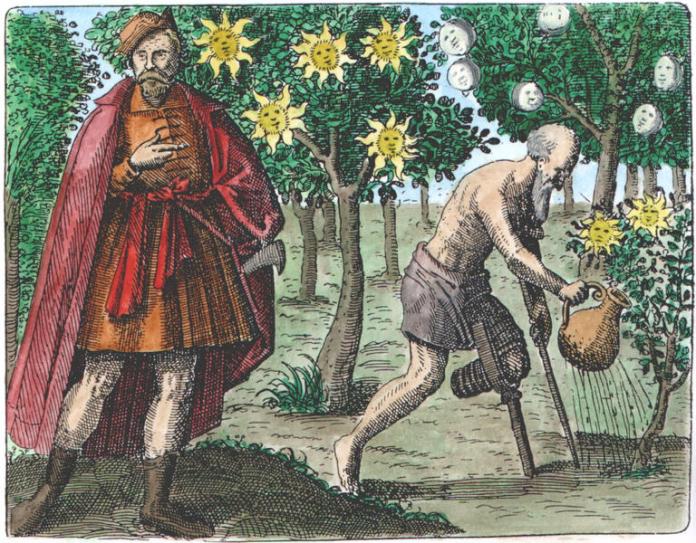
Sendivogius from Michael Maier, Symbola aurea mensae, Frankfurt, 1617. © Adam McLean 1997-2017 (alchemywebsite.com). Used with permission.
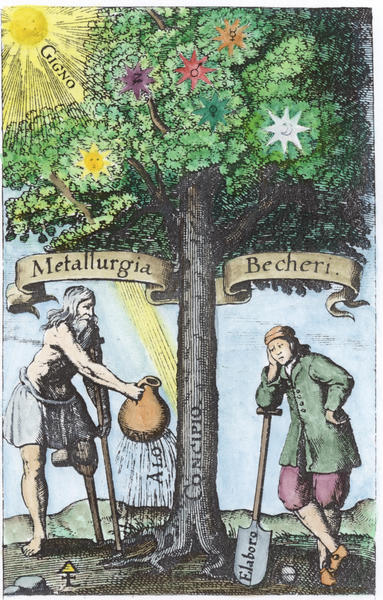
Johann Joachim Becher, Natur-Kündigung der Metallen, Frankfurt, 1661. © Adam McLean 1997-2017 (alchemywebsite.com). Used with permission.
The list ends with an ominous[72] figure called the “one” or “unique man” (ištēn etlu) – depicted as the “ideal king”, the mediator between god and man, the “exalted shepherd”, who is given everlasting dominion over all nations from the god(s).[73]
The prince is told that this is his ancestor, a “conqueror” and “high priest of Assur”[74] – a role exclusively reserved for Neo-Assyrian kings. He is also told that this ancestor “ate the taboo and stamped on the abomination” – two noteworthy points, as we will see.[75]
His body is said to be “black like pitch”, his face “like the Anzû bird,”[76] and he is wearing a red robe.[77]

“Eyes Wide Shut” Artist Print (AP), J.S. Rossbach (Click to enlarge)

The Anzû or “storm-bird” (Sumerian IM.DUGUD, “heavy rain”, i.e., a flood of waters; in Akkadian, “the wise one of heaven”) is a famous mythic creature – depicted as an eagle with a lion’s face – that is first recorded in the Old Babylonian era.
It is said to be a “worker of evil, who raised the head of evil”[78]. In the Epic of Anzû, this brazen rebel lusts after the Tablets of Destiny – the key to world rule – and proceeds to steal them from the supreme deity, thus gaining total control over the universe, the gods, and the fates of all.
In other words, Anzû was a thieving “time god” … remarkably reminiscent – or rather, prescient – of Mercury-Hermes, “the Sage, the Babylonian”, god of the alchemists.
The “vision” concludes with Nergal, the King of the Underworld, sparing the prince’s life – why? – so that “he may return penitent to the upper world to begin the glorification of Nergal”[79].
Assyriologists have identified the “crown prince” as Assurbanipal, who “alone among Neo-Assyrian kings, described himself as a scribe”[80]. Indeed, in another text he is depicted in a personal dialogue with Nabû, the god of writing.[81]
Assurbanipal is a most interesting figure for other reasons too, as we will see.
His deceased “father” ([šu]-u zār[û ]ka : “he is your ancestor”) – the “one” or “unique man” referred to in the Vision – is identified as Assurbanipal’s grandfather, Sennacherib (Akkadian: Sîn-ahhī-erība, “Sîn has replaced the brothers”), king of Assyria 705-681 BC.
In biblical texts, Sennacherib is recorded as having besieged Jerusalem, the capital of the rebellious kingdom of Judah, and finally left Hezekiah on the throne as a vassal ruler (c. 701 BC).[82]

Judean captives being led away into slavery by the Assyrians after the siege of Lachish in 701 B.C. (Source: Wikipedia)
In a striking similarity to other idolised figures in freemasonry and related secret societies (King Solomon, Hiram “King of Tyre”[83], etc), Sennacherib was a great builder – his “Palace Without Rival” is thought to have been the prototype for, or even the actual Hanging Gardens of (not) ‘Babylon’.[84]
Sennacherib is famed for his military campaigns to put down repeated Babylonian rebellions against Assyrian rule.

Hexagonal clay prism, foundation record lists campaigns of Sennacherib until the start of his final war against Babylon, and includes a description of the tribute received from Hezekiah, King of Judah in 701 BC. British Museum #91032. (Source: Osama Shukir Muhammed Amin, published 31 March 2014 under Creative Commons: Attribution-NonCommercial-ShareAlike licence)
His assassination “in obscure circumstances”[85] – believed to have been at the hand of one or more of his own sons[86] – was seen as divine vengeance, a punishment for his complete destruction of Babylon in 689 BC.
“Rabbi Nathan met the prophet Elijah. He asked him, ‘What was the Holy One, Blessed be He, doing in that hour?’
“Said Elijah, ‘He was laughing and saying, “My children have defeated me, my children have defeated me.””‘
Babylonian Talmud, Bava Mezia 59b[87]
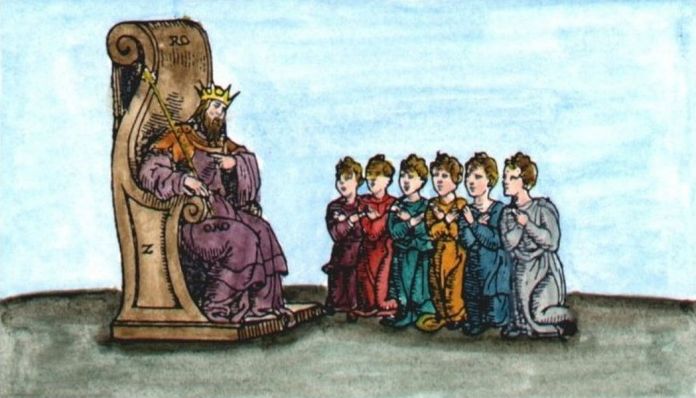
First engraving (of 14), ‘Petrus Bonus’ series, Pretiosa margarita novella de thesauro, ac pretiosissimo philosophorum lapide, Venice, 1546. © Adam McLean 1997-2017 (alchemywebsite.com). Used with permission.

Second engraving (of 14), ‘Petrus Bonus’ series, Pretiosa margarita novella de thesauro, ac pretiosissimo philosophorum lapide, Venice, 1546. © Adam McLean 1997-2017 (alchemywebsite.com). Used with permission.

Michael Maier, Atalanta Fugiens: Emblemata Nova de Secretis Naturae Chymica, 1618. © Adam McLean 1997-2017 (alchemywebsite.com). Used with permission.
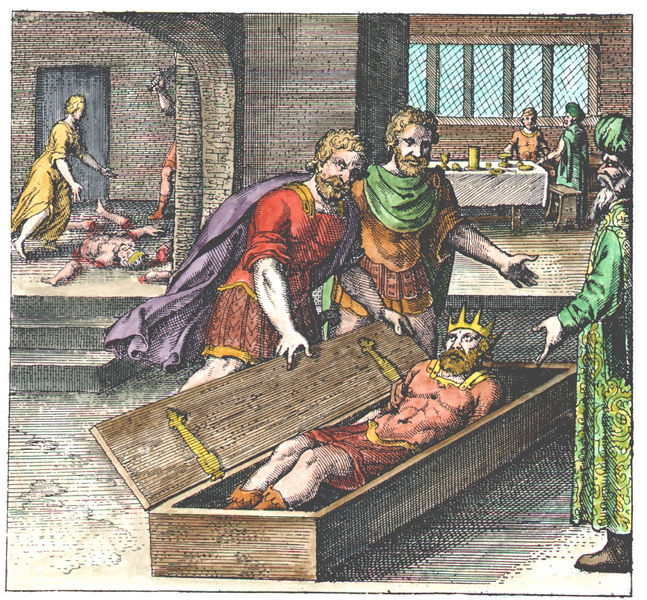
Michael Maier, Atalanta Fugiens: Emblemata Nova de Secretis Naturae Chymica, 1618. © Adam McLean 1997-2017 (alchemywebsite.com). Used with permission.

Michael Maier, Viatorium, Oppenheim, 1618. © Adam McLean 1997-2017 (alchemywebsite.com). Used with permission.

Eleventh engraving (of 14), ‘Petrus Bonus’ series, Pretiosa margarita novella de thesauro, ac pretiosissimo philosophorum lapide, Venice, 1546. © Adam McLean 1997-2017 (alchemywebsite.com). Used with permission.
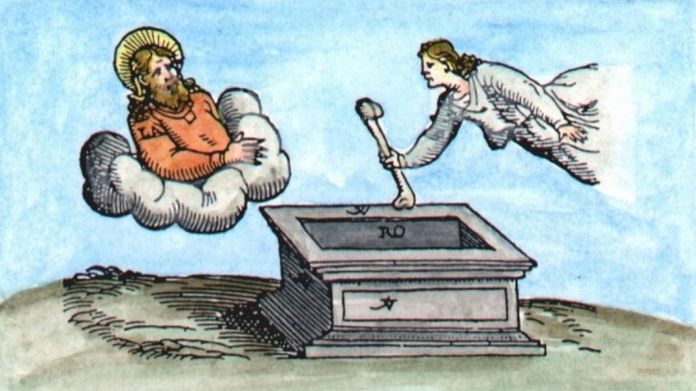
Twelfth engraving (of 14), ‘Petrus Bonus’ series, Pretiosa margarita novella de thesauro, ac pretiosissimo philosophorum lapide, Venice, 1546. © Adam McLean 1997-2017 (alchemywebsite.com). Used with permission.

Thirteenth engraving (of 14), ‘Petrus Bonus’ series, Pretiosa margarita novella de thesauro, ac pretiosissimo philosophorum lapide, Venice, 1546. © Adam McLean 1997-2017 (alchemywebsite.com). Used with permission.

Fourteenth engraving (of 14), ‘Petrus Bonus’ series, Pretiosa margarita novella de thesauro, ac pretiosissimo philosophorum lapide, Venice, 1546. © Adam McLean 1997-2017 (alchemywebsite.com). Used with permission.
Sennacherib is identified in the Underworld Vision text as the one who built “the Akitu house.” This was the temple for the twice-yearly festivals celebrating the sowing and reaping of the barley crop.
Importantly, other sources[88] show that Sennacherib rebuilt the Akitu temple, in 683 BC – two of them, one outside the walls of Assur, the other outside Nineveh – some six years after his total destruction of Babylon and its Akitu temple, located directly outside the famous Ishtar gate.
The Akitu (“barley”) New Year festival had begun with the Sumerians. Their calendar had featured two Akitu festivals: one in the Autumn in the month of Tashritu, which celebrated the “barley-sowing”; the other, in Spring in the month of Nisannu, which celebrated the “barley-cutting”.
The Babylonians also celebrated the Akitu but only the Spring (“reaping”) Nisannu – an eleven day festival honouring their supreme god Marduk, and his crown prince Nabû, the god of writing.[89]
Sennacherib was hated by the Babylonians, not only for his dominion over their former empire and ultimate destruction of their capital city but also for his apparent disregard for their religious beliefs, gods, and ceremonies.
The Akitu temple was known as the “House Which Binds Death/the Sea.”[90][91]
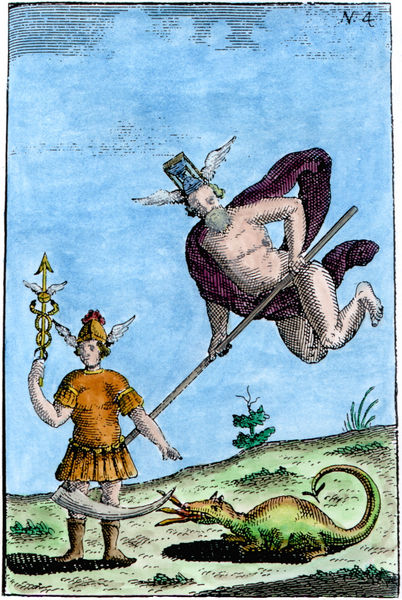
Chronos (“Time”) and Mercury-Hermes. Dragon symbolises the female (debt) principle | Abraham Eleazar, Uraltes chymisches Werck, ‘Flamel’, 1735. © Adam McLean 1997-2017 (alchemywebsite.com). Used with permission.
The Law of Inversion (or reversal) has a close relationship with the Unity of Opposites principle – like two sides of the same coin. It follows by deductive reasoning.
Because all things are believed to be created out of the natural union of two equal opposites, it is therefore possible to manipulate, and dominate all things, by developing methods to attract (“charm”), and “bind”, the “light” (or, the “dark”) “force” – gender – that one wishes to control.

Michael Maier, Atalanta Fugiens, Emblemata Nova De Secretis Naturae Chymica, 1618. © Adam McLean 1997-2017 (alchemywebsite.com). Used with permission.
To do so implies the “need” for deception, and, the precise inversion of natural and sovereign laws, traditional moral and ethical values, and social taboos.
This Law of Inversion (or reversal) is the esoteric (for initiates-only), “revolutionary” principle that lies at the heart of all forms of alchemical “magic” or “transformation”.
In other words, it is the principle of lying, and cheating.
It is the principle of re-presenting the true, with the un-true.
Faking it.
Creating an illusion, or counterfeiting the real thing.
The earliest overt evidence for the practice of values inversion is found in the cult worship of Inanna, the Mesopotamian “goddess” of Sex (union, creation, life) and War (separation, destruction, death).
A vivid embodiment of the Unity of Opposites androgyne principle, “she” was also known – in some or all of “her” aspects – as Ishtar (Akkadia, Assyria and Babylonia), as Ashtoreth or Astarte (Canaan), as Venus (Greece), and as Aphrodite (Rome).
Inanna’s cult celebrations were debauched – meaning, de-valued – “carnivalesque” affairs that deliberately broke all laws, social taboos, natural and social boundaries. They were a time for “disorder and antistructure”.
In a word, chaos.

Barent Coenders van Helpen, L’Escalier des Sages (“The Stairs of the Wise”), Cologne, 1693. © Adam McLean 1997-2017 (alchemywebsite.com). Used with permission.
The rituals were “creative negation” that reminded Inanna’s devotees of “the need to reinvest the clean with the filthy, the rational with the animalistic”.
They are said to “confirm the endless potentiality of dirt and the pure possibility of liminality” – meaning, the ambiguity, and disorientation that is felt by a ritual initiate when “standing at the threshold” of transformation from a previous state into a new, opposite state (from Latin līmen, “a threshold”)[92].
Through the deliberate inversion of values, Inanna’s cult personnel – transvestites[93] – “attack[ed] the basic categorical differences between male and female, human and animal, young and old”[94]:
To turn a man into a woman and a woman into a man are yours, Inanna….
Business, great winning, financial loss, deficit are yours, Inanna….
She (Ishtar) [changes] the right side (male) into the left side (female), she [changes] the left side into the right side, she [turns] a man into a woman, she [turns] a woman into a man, she ador[ns] a man as a woman, she ador[ns] a woman as a man.[95]

J.D. Mylius, Rosary of the Philosophers (Rosarium philosophorum sive pretiosissimum donum Dei), 1622. © Adam McLean 1997-2017 (alchemywebsite.com). Used with permission.
The representations of the “goddess” are their own testament to this shattering and confusion of boundaries – the “Queen of the Night” is a deity in human form, and also, part woman and part owl.
“She” has been compared to the Jewish demon Lilith, a seducer, a kidnapper and slayer of children “who appear[s] to human beings, to men in the likeness of women and to women in the likeness of men” – “[t]he traditional depiction of Lilith from ancient Mesopotamia through medieval Kabbalah presents an antitype of desired human sexuality and family life.”[96]

The Burney (Queen of the Night) Relief; c. 1800-1750 BC (Old Babylonian). British Museum 2003,0718.1
Pleased to meet you,
Hope you guessed my name,
But what’s confusing you
Is just the nature of my game
Just as every cop is a criminal
And all the sinners saints
As heads is tails
Just call me Lucifer
The medieval alchemists saw their androgyne “time god” – the “Grand Sorcerer”, Mercury-Hermes: a silver-tongued liar and thief, a “producer” of gold, a hegemonic “Master of the Universe” who transcends life and death, a traveller and merchant, a mediator between the real and unreal worlds – as boasting the same power of inversion, enabling mimickry (i.e., faking it, counterfeiting):
The male tantric master [..] has the power to assume the female form of the goddess (who is of course an aspect of his own mystical body), that is, he can appear in the figure of a woman. Indeed, he even has the magical ability to divide himself into two gendered beings, a female and a male deity. He is further able to multiply himself into several maha mudras.[97]
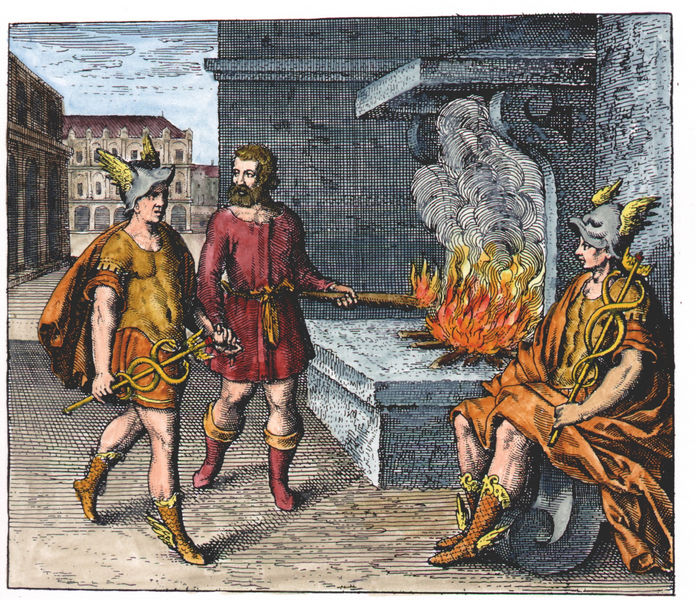
Michael Maier, Atalanta Fugiens: Emblemata Nova de Secretis Naturae Chymica, 1618. © Adam McLean 1997-2017 (alchemywebsite.com). Used with permission.
Outside of Luciferianism, Satanism, and various “magick” cults and male-only (“brotherhood”) societies of the ancient past and present, the primary purveyor of the Law of Inversion in the modern era is Jewish Cabala. In particular, the world-wide Chabad-Lubavitch sect, founded in 1775.
As we have seen, its theurgic (“magic”) doctrine has been traced back “ultimately to old Chaldea”. The Jewish Encyclopedia tells us that “the apocalyptic literature belonging to the second and first pre-Christian centuries contained the chief elements of the Cabala”.[98]
Unsurprisingly then, the Law of Inversion principle also appears in Cabalist doctrine, precisely as it does in the Inanna-Ishtar cult, medieval Tantric Buddhism, and medieval Western alchemy:
It appears that the acosmic background of Habad thought influenced the acceptance of the nihilistic doctrine of inversion, for in a doctrine where the existence and nonexistence of reality are one and the same for God, and a religious view in which Yesh [Something] and Ayin [Nothing] are equal, good and evil are also equated with one another, as are positive religious action and transgression [..] The more extreme formulations, which deny the substantiality of every gradation and commonly accepted dichotomy, doubtless influenced the denial of significant value to reversals, inversions, and oppositions. [..] if “everything is absolutely as nothing and naught in relation to His being and essence,” then neither traditional distinctions nor relative and absolute values have any validity.
“Worship in inversion,” “descent for the purpose of rising up” [..] were seen to be theurgical [“magic”] missions [..] fulfilling the reverse of the divine commandment for the sake of the divine will to be revealed in all dimensions.[99]

Hans Karl von Ecker, Freymäurerische Versammlungsreden der Gold- und Rosenkreutzer des alten Systems Amsterdam, 1779. © Adam McLean 1997-2017 (alchemywebsite.com). Used with permission.
[T]hrough breaking a taboo for which there is often a high penalty, the adept confirms the core of the entire Buddhist philosophy: the emptiness (shunyata) of all appearances. “I am void, the world is void, all three worlds are void”, the Maha Siddha Tilopa triumphantly proclaims — therefore “neither sin nor virtue” exist. The shunyata principle thus provides a metaphysical legitimization for any conceivable “crime”, as it actually lacks any inherent existence.[100]
In both Eastern and Western alchemy, the starting point for an alchemical “transformation” is the realm of primal matter – the impure, ignoble, or base.
The female (passive, negative, liability; also, since the 1789 French Revolution, “conservative”, “Right”).
According to the Law of Inversion – and a monstrous Ego – the “skilled” magician can transform it (the “female”) into something pure, noble and divine.
The male (active, positive, asset; since 1789, “progressive”, “Left”):

In European alchemy the coarse starting material for the experiments is known as the prima materia and is of a fundamentally feminine nature. Likewise, as in the tantras, base substances such as excrement, urine, menstrual blood, part of corpses and so forth are named in the alchemic texts, no matter which culture they belong to, as the physical starting materials for the experiments. Symbolically, the primal material is described in images such as “snake, dragon, toad, viper, python”. It is also represented by every conceivable repulsive female figure — by witches, mixers of poison, whores, chthonic goddesses, by the “dragon mother” so often cited in depth psychology. All these are metaphors for the demonic nature of the feminine [..] Shakyamuni compared women in general with snakes, sharks and whores.[101]
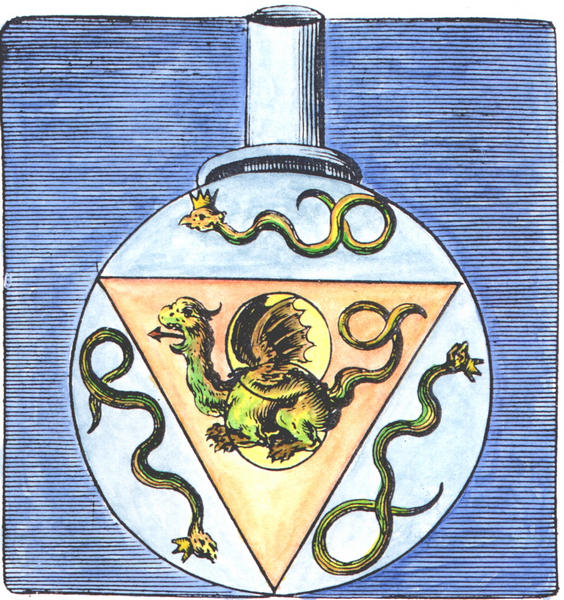
Engraving from Valentine’s ‘Twelve Keys’ in the Musaeum hermeticum, Frankfurt, 1678. © Adam McLean 1997-2017 (alchemywebsite.com). Used with permission.
These misogynous terms for the prima materia are images which on the one hand seek to describe the untamed, death-bringing nature; on the other one readily admit that a secret force capable of producing everything in the phenomenal world is hidden within “Mother Nature”. Nature in alchemy has at its disposal the universal power of birth. It represents the primordial matrix [▽] of the elements, the massa confusa, the great chaos, from which creation bursts forth.[102]

J.D. Mylius, Philosophia Reformata, 1622 © Adam McLean 1997-2017 (alchemywebsite.com). Used with permission.
There are also European manuals of the “great art” which require that one work with the “menstrual blood of a whore”.[103]

Des beruhmten Philosophi Nicolai Flamelli, Chymische Werke, 1751. © Adam McLean 1997-2017 (alchemywebsite.com). Used with permission.
One text talks of “the transformation of the Babylonian whore into a virgin”.[104]

J.D. Mylius, Anatomia Auri, 1628. © Adam McLean 1997-2017 (alchemywebsite.com). Used with permission.
But in order to transform the female into the male, a negative into a positive, a liability into an asset, lead into “gold”, evil into “good” – and so possess the secret birth-force in himself – there is something the lying cheating “time god” must do.
He must kill the essential feminine.
He must destroy the “mother” nature:
Experimenting around with the primal material sounds quite harmless to someone who is not initiated. Yet a symbolic murder is hidden behind this. The black matter, a symbol of the fundamental feminine and of powerful nature from which we all come, is burned or in some cases vaporized, cut to pieces or dismembered. Thus, in destroying the prima materia we at the same time destroy our “mother” or, basically, the “fundamentally feminine”.
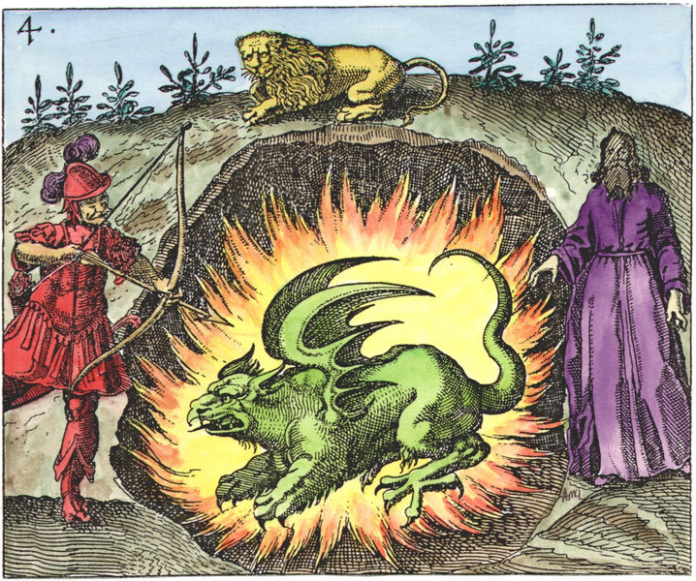
J.D. Mylius, Philosophia Reformata, 1622. © Adam McLean 1997-2017 (alchemywebsite.com). Used with permission.
The European adept does not shy away from even the most crass killing metaphors: “open the lap of your mother”, it says in a French text from the 18th century, “with a steel blade, burrow into her entrails and press forward to her womb, there you will find our pure substance (the elixir)”. Symbolically, this violent first act in the alchemic production is located within a context of sacrifice, death and the color black and is therefore called nigredo, that is “blackening”.[105]

Aurora Consurgens, 15th century. © Adam McLean 1997-2017 (alchemywebsite.com). Used with permission.
A sacrifice of the feminine [..] may be found in the logic of the entire Buddhist doctrine. Woman per se – as Buddha Shakyamuni repeatedly emphasized in many of his statements — functions as the first and greatest cause of illusion (maya), but likewise as the force which generates the phenomenal world (samsara). It is the fundamental goal of every Buddhist to overcome this deceptive samsara. This world of appearances experienced as feminine, presents him with his greatest challenge. “A woman”, Nancy Auer Falk writes, “was the veritable image of becoming and of all the forces of blind growth and productivity which Buddhism knew as Samsara. As such she too was the enemy — not only on a personal level, as an individual source of temptation, but also on a cosmic level”. In this misogynist logic, it is only after the ritual destruction of the feminine that the illusory world (maya) can be surmounted and transcended.[106]

Last of Basil Valentine’s Twelve Keys, from Michael Maier, Tripus Aureus (Golden Tripod), Frankfurt, 1618. © Adam McLean 1997-2017 (alchemywebsite.com). Used with permission.
“In … Tantrism … woman is means, an alien object, without possibility of mutuality or real communication”. The woman “is to be used as a ritual object and then cast aside”. Or, at another point: the yogis had “sex without sensuality … There is no relationship of intimacy with an individual — the woman … involved is an object, a representation of power … women are merely spiritual batteries”.[107]
Autumn’s leaving
And Winter’s coming
I think that I’ll be moving along
I’ve got to leave her
And find another
I’ve got to sing my heart’s
True song

Leonard Thurneisser, Archidoxa, 1575. © Adam McLean 1997-2017 (alchemywebsite.com). Used with permission.
Is it for this reason that maya (illusion), the mother of the historical Buddha, had to die directly after giving birth? In her early death we can recognize the original event which stands at the beginning of the fundamentally misogynist attitude of all Buddhist schools. Maya both conceived and gave birth to the Sublime One in a supernatural manner. It was not a sexual act but an elephant which, in a dream, occasioned the conception, and Buddha Shakyamuni did not leave his mother’s body through the birth canal, but rather through her hip. But these transfeminine birth myths were not enough for the tellers of legends. Maya as earthly mother had [..] to be proclaimed an “illusion” (maya) and destroyed.[108]

Michael Maier, Viatorium, Oppenheim, 1618. © Adam McLean 1997-2017 (alchemywebsite.com). Used with permission.
Every type of passion (sexual pleasure, fits of rage, hate and loathing) which is normally considered taboo by Buddhist ethical standards, is activated and nurtured in Vajrayana with the goal of then transforming it into its opposite. The Buddhist monks, who are usually subject to a strict, puritanical-seeming set of rules, cultivate such “breaches of taboo” without restriction, once they have decided to follow the “Diamond Path”. Excesses and extravagances now count as part of their chosen lifestyle. Such acts are not simply permitted, but are prescribed outright…
[T]he Kalachakra Tantra exhorts its pupils to commit the following: to kill, to lie, to steal, to break the marriage vows, to drink alcohol, to have sexual relations with lower-class girls. A Tantric is freed from the chains of the wheel of life by precisely that which imprisons a normal person.[109]
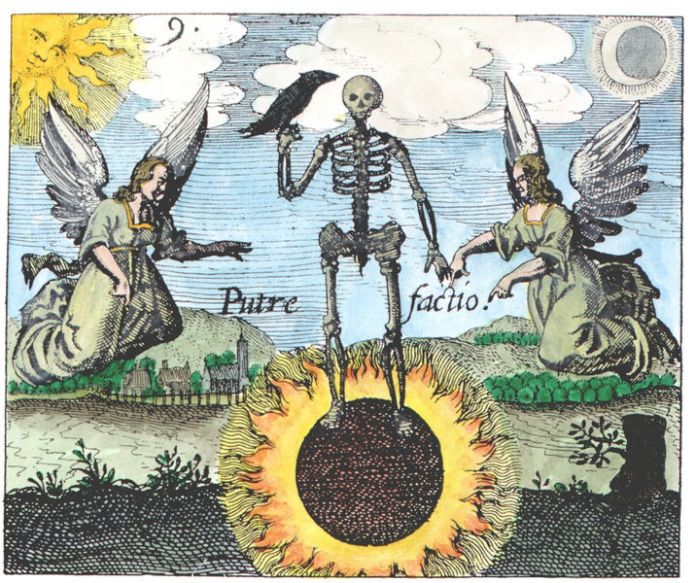
J.D. Mylius, Philosophia reformata, 1622. © Adam McLean 1997-2017 (alchemywebsite.com). Used with permission.
A central role in the rites is played by the tantric meal. It is absolutely forbidden for Buddhist monks to eat meat or drink alcohol. This taboo is also deliberately broken by Vajrayana adepts. To make the transgression more radical, the consumption of types of meat which are generally considered “forbidden” in Indian society is desired: elephant meat, horsemeat, dogflesh, beef, and human flesh. The latter goes under the name of maha mamsa, the “great flesh”.
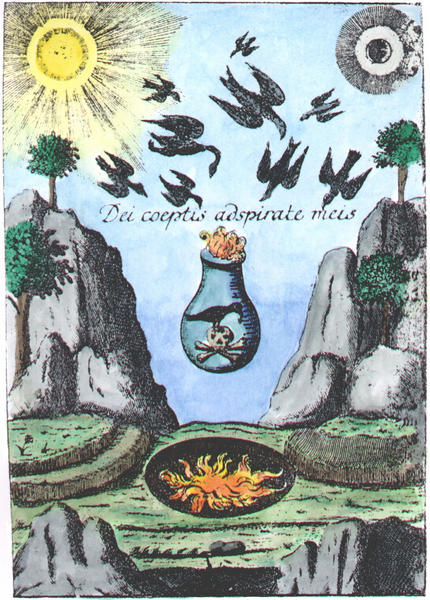
Microcosmische vorspiele des neuen Himmels und der neuen Erde, 1744. © Adam McLean 1997-2017 (alchemywebsite.com). Used with permission.
In the Hevajra Tantra the adept must drink the menstrual blood of his mudra out of a skull bowl. But rotten fish, sewer water, canine feces, corpse fat, the excrement of the dead, sanitary napkins as well as all conceivable “intoxicating drinks” are also consumed.[110]
As a tantric saying puts it, “What binds the fool, liberates the wise”, and another, more drastic passage emphasizes that, “the same deed for which a normal mortal would burn for a hundred million eons, through this same act an initiated yogi attains enlightenment”. According to this, every ritual is designed to catapult the initiand into a state beyond good and evil.[111]

Joannis Agricola, Commentariorum, Notarum, Observationum & Animadversionum, in Johannis Poppii chymische Medicin, Leipsig, 1638. © Adam McLean 1997-2017 (alchemywebsite.com). Used with permission.
[The third] justification for the “transgressions” of the Vajrayana consists in the Bodhisattva vow of Mahayana Buddhism, which requires that one aid and assist every creature until it attains enlightenment. Amazingly, this pious purpose can render holy the most evil means. “If”, we can read in one of the tantras, “for the good of all living beings or on account of the Buddha’s teaching one should slay living beings, one is untouched by sin. … If for the good of living beings or from attachment for the Buddha’s interest, one seizes the wealth of others, one is not touched by sin”, and so forth. In the course of Tibetan history the Bodhisattva vow has [..] legitimated numerous political and family-based murders, whereby the additional “clever” argument was also employed, that one had “freed” the murder victim from the world of appearances (samsara) and that he or she thus owed a debt of thanks to the murderer.[112]
These two principles – the Unity of Opposites and the Law of Inversion – were evidently the foundation of all human reasoning for the “philosophers” of the “royal art” of cheating “females” in ancient Mesopotamia.
The Unity of Opposites explained all things, in the heavens (Above) and the earth (Below).
The Law of Inversion explained how to gain control over all things, Above and Below.
By deception, and reversal.
All that remained, is a question of method.
Since all things are believed to contain both a masculine and a feminine principle, then the method for gaining control over all things, is to use the “magnetic” power of sexual attraction, to tempt or “draw in” the force or power that one wishes to “bind”.
Which organ has maximum utility (usefulness) for achieving this?
In Inanna’s words to her shepherd-king “bull” bridegroom Dumuzi, a “honey-sweet” tongue[113]:
Make your milk sweet and thick, my bridegroom,
My shepherd, I will drink your fresh milk,
Wild bull, Dumuzi, make your milk sweet and thick.
I will drink your fresh milk.
Let the milk of the goat flow in my sheepfold,
Fill my holy churn with honey cheese,
Lord Dumuzi, I will drink your fresh milk.
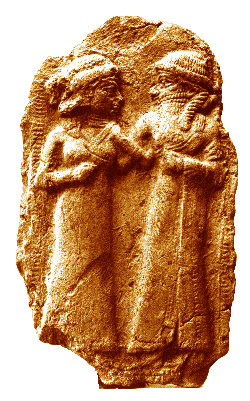
Sacred Marriage of Inanna and Dumuzi. (Source: Wikipedia. Public Domain licence)
My honey-man, my honey-man sweetens me always.
My lord, the honey-man of the gods,
He is the one my womb loves best.
His hand is honey, his foot is honey,
He sweetens me always.
He laid me down on the fragrant honey-bed,
My sweet love, lying by my heart,
Tongue-playing, one by one,
My fair Dumuzi did so fifty times.[114]
[There ended the “honey-moon”]
Or, in Mercury-Hermes’ words, a mercurial (quicksilver) tongue:
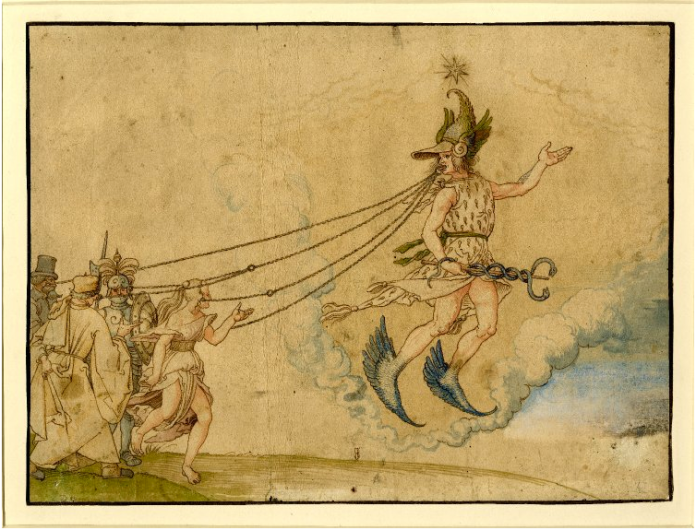
“Allegory of Eloquence”, Albrecht Dürer, c. 1498. (British Museum)
Since at the end of the sexual magic rituals the masculine principle alone remains, the verbal praise of the goddess, beauty and love could also be manipulative, designed to conjure up the devotion of a woman. [..] [W]e must regard such charming flattery of the female sex as at the very least a non-committal, albeit extremely lucrative embellishment. But they are more likely to be a deliberately employed manipulation, so as to draw attention away from the monstrosities of the tantric ritual system. Perhaps they are themselves a method (upaya) with which to appropriate the “gynergy” of the women so charmed. After all, something like that need not only take place through the sexual act. There are descriptions in the lower tantras of how the yogi can obtain the feminine “elixir” even through a smile, an erotic look or a tender touch alone.[115]

Third of Basil Valentine’s Twelve Keys, from Michael Maier, Tripus Aureus (Golden Tripod), Frankfurt, 1618. © Adam McLean 1997-2017 (alchemywebsite.com). Used with permission.
One example of this manipulation of sexual “magnetism”, is an Old Babylonian method for controlling the forces of good or evil fortune, by an incantation (“s.p.e.l.l.”) spoken over a magic figurine:
A pair of supernatural beings, demons of some kind, are said to accompany man [..] one is called mukīl rēš daniqti, or rabis damiqti, “he who offers good things,” or “good demon”; the other is mukīl rēš lemutti, or rabis lemutti “he who offers misfortune” or “evil demon.” [..] A similar reference can be found in Greek literature – suffice it to mention here the scales of Zeus and his mixing of the “good and bad things” from the two jars (Iliad 24:527).[116]

J.D. Mylius, Philosophia Reformata, 1622. © Adam McLean 1997-2017 (alchemywebsite.com). Used with permission.
Mukīl rēš lemutti, inscribed in cuneiform Sumerian syllabograms as (d)SAG.ḪUL.ḪA.ZA and meaning “he who holds the head of evil”, was an ancient Mesopotamian winged leonine demon, a harbinger of misfortune associated with benign headaches and wild swings in mood, where the afflicted “continually behaves like an animal caught in a trap.”[117]
The [evil] demon frequently appears in prescriptions such as those for the fashioning of a figurine for a neurological disorder caused by a pursuing ghost, where “The evi[l confusional stat]e (causing ghost or) mukīl rēš lemutti-demon [which] was set [on] (personal name) son of (personal name)–he is your husband. You are given [t]o him (as wife).”[118]

The Lion of Venice in Piazza San Marco, 1870s (Photo: Carlo Naya, 1822-1881, via Wikipedia)

Winged lions on Holborn Viaduct, City of London.
The production of magico-religious objects such as figurines and erotic plaques was widespread in Old Babylonia. They were strategically positioned at thresholds – zones of transformation, or a change in state between two equal opposites.
Like, say, the transition between Inside and Outside your house.
Or, let’s say, between a Credit and Debit “balance” of your “account” rented from a cheating time lord:
Ancient Mesopotamians envisioned liminal zones in general as having great magical potency, for better or for worse. Gates, doorways, windows, crossroads, shrines, beds and even the sexually aroused body, to name some, were the perceived spacial correlates of an invisible membrane through which the worlds of the seen and the unseen, of the magical and the mundane interacted. Since these intersections amplified paranormal activity, they were usually manipulated to ensure activity of a positive nature.

J. Assante, Sex, Magic, And The Liminal Body In The Erotic Art And Texts Of The Old Babylonian Period (2002). (Photo: J. Assante, courtesy of the Vorderasiatisches Museum, Berlin)
Old Babylonian plaques were themselves liminal, serving as points where inhabitants of the non-physical universe could emerge and affect every day reality.
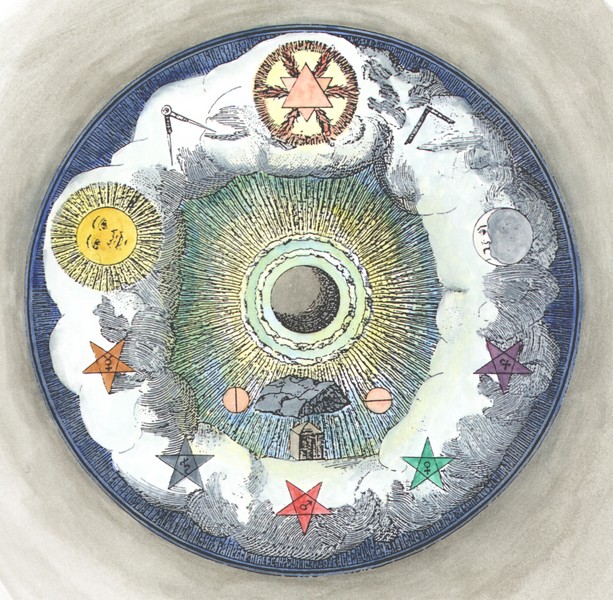
Masonic alchemical image from Die Theoretischen Brüder oder zweite Stufe der Rosenkreutzer, 1785. © Adam McLean 1997-2017 (alchemywebsite.com). Used with permission.
Old Babylonian visual erotica inserts the liminal by structuring scenes around sexual anatomy. The general term for body orifice, KA in Sumerian or bãbu in Akkadian, is expressly liminal because it also means door or gate. The vaginal opening, bãb uri and the anus bãb šuburri are imagined then as thresholds. From literary and incantation texts we know that the body and its orifices were regarded as sites of transition, especially when aroused. In the Old Babylonian period, it is usually Inanna’s excited thresholds that work to effect white magic [..] whereas in the first-millennium BCE Gilgamesh Epic Ishtar and her vulva bring only death or castration.[119]
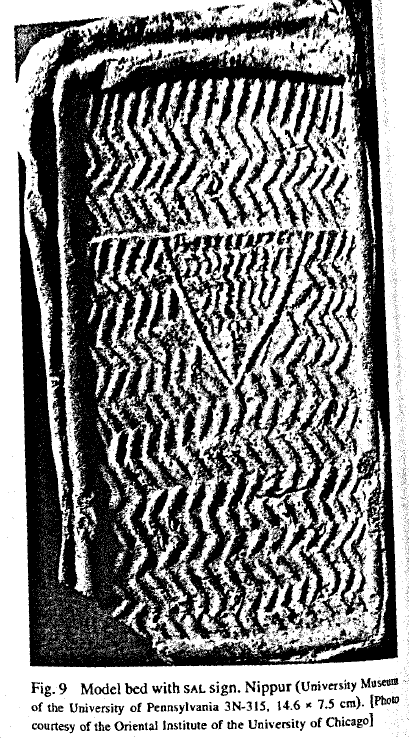
SAL (Sumerian: “woman”) | J. Assante, Sex, Magic, And The Liminal Body In The Erotic Art And Texts Of The Old Babylonian Period (2002)
We have already seen that what many call “white” and “black” magic are closely associated with the Cabala of Old Chaldea, and the “All-Wise” alchemical King Solomon – he of the “magic sign or seal” “known to the medieval Jew as the Magen Dawid” [✡], the Cabalistic key to “the whole system of conjuration of angels and demons.”
The development of the rēbus (punning) principle in ancient Sumer helps shed light on the true origin of a biblical saying that, according to rabbinic tradition, was written by King Solomon.
“Cast your bread on the surface of the waters, for you will find it after many days, Give a portion to seven, or even to eight, for you do not know what misfortune may occur on the earth”, has long been used by slick salesmen – including economists, financial advisors, fund managers, televangelists, trans-national corporate executives, politicians and bankers – in their sales pitches for charitable giving, diversified investing, and globalised “free” trade.[120]

Michael Maier, Viatorium, Oppenheim, 1618. © Adam McLean 1997-2017 (alchemywebsite.com). Used with permission.
The Marriage of the Sea
Every year on Ascension Day, the doge of Venice dropped a consecrated ring into the sea, and with the Latin words “Desponsamus te, mare, in signum veri perpetuique domini”
(“We wed thee, sea, as a sign of true and everlasting domination”) declared Venice and the sea to be indissolubly one.[121]

Michael Maier, Atalanta Fugiens: Emblemata Nova de Secretis Naturae Chymica, 1618. © Adam McLean 1997-2017 (alchemywebsite.com). Used with permission.
In Sumer, most aspects of life appear to have revolved around the production and consumption of beer. This was the official libation (ritual drink offering) to Inanna-Ishtar, patron goddess and harimtu (prostitute, or libidinous single female)[122] of the tavern.
It was also a common cause of insolvency due to unrepayable bar debts, incurred by offering alcohol on credit[123] – a trading method that was broadly repeated in the Russia Empire in the 18th-19th centuries.[124]
In Sumer, beer was made by casting bread into jars of water:
The passage of Qoh. xi 1-2 has traditionally been understood as a call for charity or international trade. However, in the light of the procedure by which beer was made in the ancient Near East … a more likely interpretation is that Qoheleth is recommending beer production and consumption in perilous times.[125]
In other words, this “wisdom of Solomon” is a (profitable, for some) command to brew, drink and be merry, for tomorrow we may die.
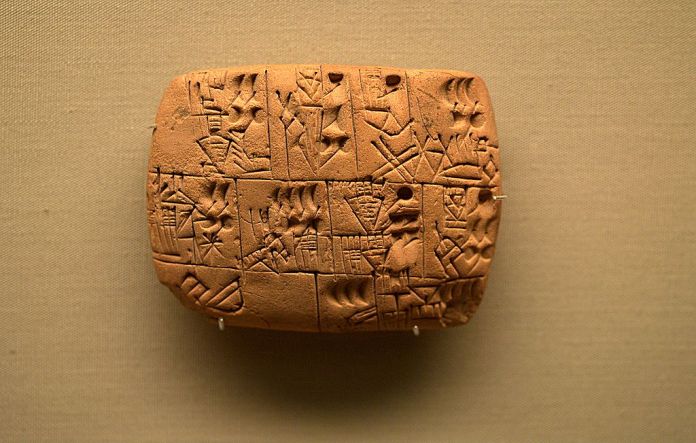
Cuneiform Pictographs Recording the Allocation of Beer. Thought to be from southern Iraq Late Prehistoric period, about 3100-3000 BC. (Source: Jim Kuhn [CC BY 2.0], via Wikimedia Commons)
For the Sumerians, beer was considered a magical potion. It was commonly compared to an attractive and promiscuous female. Both had the ability to “seize” or “bind” the drinker. In an Old Babylonian incantation (spell) recited by a woman “to bend her straying lover to her will”, the “chief tools of magic making are the female’s aroused body orifices”.[126]
Inanna-Ishtar is the central figure in these rites and incantations. An Old Babylonian hymn to “Inanna-Nine-galla” (galla: androgynous demons) is set at dusk, when the two clear opposites of day and night blur.
Exactly like Lucifer in biblical writings, Inanna-Ishtar identifies “her”self in the texts with both the morning and evening star.
Inanna’s celestial body has the nature of a shape-shifter: as “her” star rises through the transition of light to dark (and vice versa), so too does Inanna-Ishtar the harimtu. When named Kilili (“Lady Owl”), “she” is “the harlot who like the owl comes out at dusk”[127], and sits at the door of the tavern to entice customers.
From a namburbi incantation, we learn that Inanna’s presence was invoked to create an ambiance of enchantment, with the purpose being to “effect magical gains of a non-sexual nature” – that is, to secure “brisk trade”.[128]
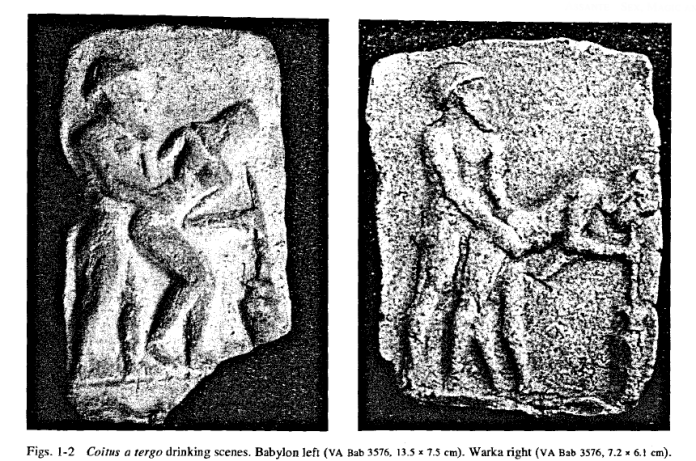
J. Assante, Sex, Magic, And The Liminal Body In The Erotic Art And Texts Of The Old Babylonian Period (2002). (Photo: J. Assante, courtesy of the Vorderasiatisches Museum, Berlin)
It is here too, that archaeologists have discovered cuneiform fragments in Nineveh and Babylon, from which we learn that alchemists have had secret recipes for creating fake silver since before the reign of Nebuchadnezzar I (c. 1124-1103 BC). Word puns in the recipe suggest that it was made in a form that counterfeited the royal standard ingots:
“When rubbed and polished these (objects) are ziqpu (or ziqiptu) of silver. This (kind of) silver [can]not [be detected].”
What makes this severely mutilated prescription so interesting and intriguing is the [..] passage which addresses the chemist directly: “Do not be careless (with respect to these instructions). Do not [show] (the procedure) to anyone!” References to secrecy do not occur anywhere else in the cuneiform texts dealing with instructions written for specific crafts.[129]
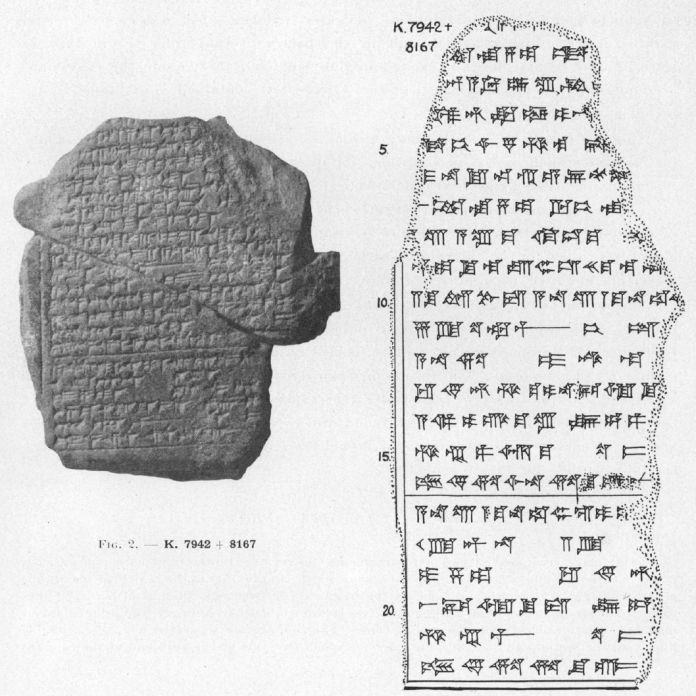
These recipes are remarkable for a multitude of reasons.
The older of the two ends in a colophon stating that it is a copy, and is the property of Nebuchadnezzar I, King of Babylon.
The other (above) was found as part of the famous royal library of King Assurbanipal (c. 685 BC – 627 BC) in Nineveh; a collection of around 30,000 tablets and fragments, said to be the most compelling discovery of the ancient Near East. Assurbanipal – who we met earlier – is the Assyrian “prince” who (as king) is reported to have taken the Israelite population into captivity, and replaced them with a mixture of tribes from other parts of his empire.[130]
(This may offer an explanation for why archaeologists have discovered evidence in Israel from the 7th century BC, of the Epic of Anzû – the rebel “storm-bird” who stole the Tablets of Destiny.[131])
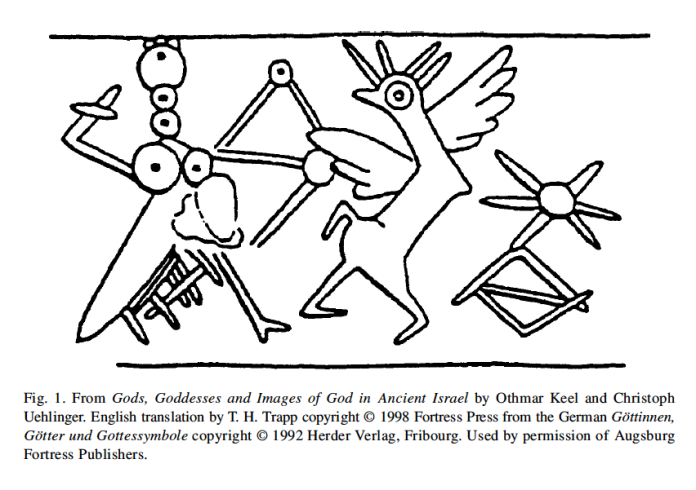
Source: Anzu and Ziz – Great Mythical Birds in Ancient Near Eastern, Biblical, and Rabbinic Traditions (2008)
There are numerous parallels between the method for producing this fake silver, and the methods cryptically described in medieval alchemical texts for producing the longed for “elixir” or “gold” of “the philosophers”.
Even more remarkable though, is the ingredients.
According to a renowned Assyriologist, whose technical expertise was expressly sought to interpret the two fragments, a “red alkali” used as a “binder” in the recipe “occurs to my knowledge only here” and in no other technical texts from the ancient world.
Similarly, the alchemical texts mention a mysterious substance called “Red Mercury”. What this actually is has been the subject of speculation for hundreds of years – and more recently, lucrative hoaxes, with far-reaching geopolitical, and economic ramifications – because it is supposed to possess a massive destructive power:
When red mercury first appeared on the international black market 15 years ago, the supposedly top secret nuclear material was ‘red’ because it came from Russia. When it resurfaced last year in the formerly communist states of Eastern Europe it had unaccountably acquired a red colour. But then, as a report from the US Department of Energy reveals, mysterious transformations are red mercury’s stock in trade. (New Scientist, 1992)
The only thing we can be sure of is that it’s a ripping yarn. Rumours that Soviet nuclear experts had produced a mysterious explosive material with unimaginable destructive power first circulated in the 1970s, and despite several official investigations and subsequent denials the story refuses to die. (The Guardian, 2004)
For decades, aspiring bomb makers — including ISIS — have desperately tried to get their hands on a lethal substance called red mercury.
Legends of red mercury’s powers began circulating by late in the Cold War. [..] Chief among its proponents was Samuel T. Cohen, the American physicist and Manhattan Project veteran often called the father of the neutron bomb [..] In one edition of his autobiography, he claimed red mercury [..] “is a remarkable nonexploding high explosive…” (New York Times, 2015)
It is an interesting coincidence that this “ripping yarn” first emerged in the 1970s, at the same time a special kind of “gate” opened – one that has flooded the world with a “nonexploding high explosive”, a red “binder”, for the past 45 years.

Two other ingredients are similarly remarkable. Milk and honey. And in a quantity that “seem[s] excessive”.
It is difficult not to be reminded here of the fascinating tale told in the Old Testament account of the Exodus, written in 273-272 BC by Jewish scholars at Alexandria in Egypt, quite possibly as a reactionary polemic against the Egyptians.[132]
We are told that once upon a time, a messianic intermediary named Moses (meaning “I drew him from the waters”) was saved from infanticide when his mother chose to hide him among the reeds of the river Nile, in a basket weaved from papyrus (used for making writing paper, and boats).
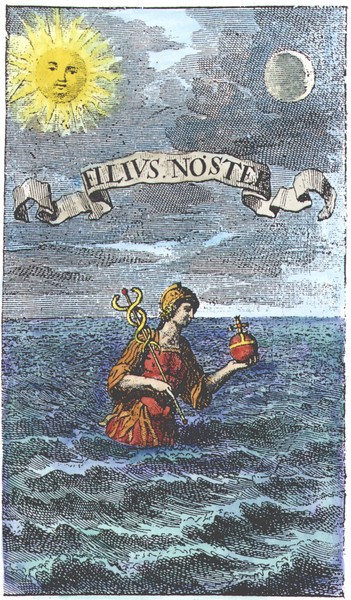
“Our son” | Mercury-Hermes emerging from the sea, JE Muller, Wunder-materia, 1707. © Adam McLean 1997-2017 (alchemywebsite.com). Used with permission.
As an adult, Moses is minding sheep when God “appears” to him – a voice speaking from a “burning bush” which doesn’t burn.
Round and round
The burning circle
All the seasons
One, two and three
Autumn comes
And then the Winter
Spring is born
And wanders free

Vajra (“diamond scepter”, “thunderbolt”, penis) Yogini in the “Burning Circle”. (Source: Trimondi, The Shadow of the Dalai Lama: Sexuality, Magic and Politics in Tibetan Buddhism)
God tells Moses to throw his “staff” or “rod” on the ground; it is transformed into a “snake”. When God tells him to grab it by the tail, it transforms back again.
A reversal.

“Seal of the Wise”, Johann Michael Faust, Philalethes Illustratus, Frankfurt 1706. © Adam McLean 1997-2017 (alchemywebsite.com). Used with permission.
The magic “rod” becomes famous as the “staff of God”, or the “rod of God”.

Michael Maier, Atalanta Fugiens: Emblemata Nova de Secretis Naturae Chymica, 1618. © Adam McLean 1997-2017 (alchemywebsite.com). Used with permission.
Moses magically brings a series of ten plagues on the Israelite’s alleged captors, the final plague killing all the “firstborn” of Egypt. On finally being allowed to exodus, he is told to “raise up” his “rod” and “stretch out” his hand over the “Red Sea”, which is divided in two, allowing the “chosen” “children” of Israel to go to the land of the Promise (“Promised Land”).
The “Land of Milk and Honey”.
Indeed, it is said to be “flowing with milk and honey.”[133]
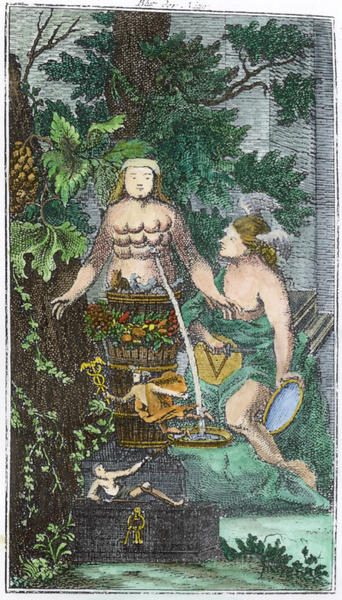
Anonymus von Schwartzfuss, Das Blut der Natur, Frankfurt and Leipzig, 1767. © Adam McLean 1997-2017 (alchemywebsite.com). Used with permission.

Urban Hjärne, Actorum Chemicorum Holmiensium, 1753. © Adam McLean 1997-2017 (alchemywebsite.com). Used with permission.
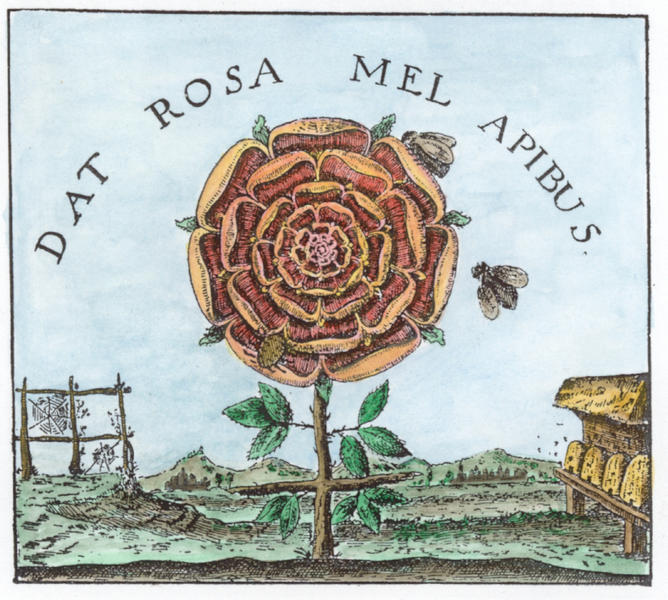
“The Rose Gives The Bees Honey” , Robert Fludd, Summum bonum, Frankfurt, 1629. © Adam McLean 1997-2017 (alchemywebsite.com). Used with permission.
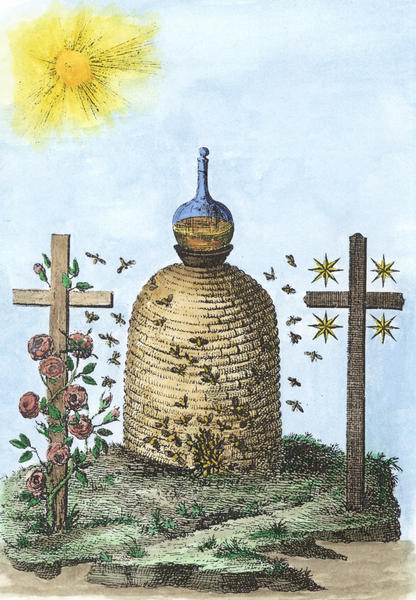
Frontispiece from Geheimnisse einiger Philosophen und Adepten, 1780. © Adam McLean 1997-2017. (alchemywebsite.com). Used with permission.
Milk and honey also feature in the alchemical sex magic rituals. Both words are used to describe the “virgin milk”; the female sexual fluids or gynergy which the male adept aims to steal for himself:
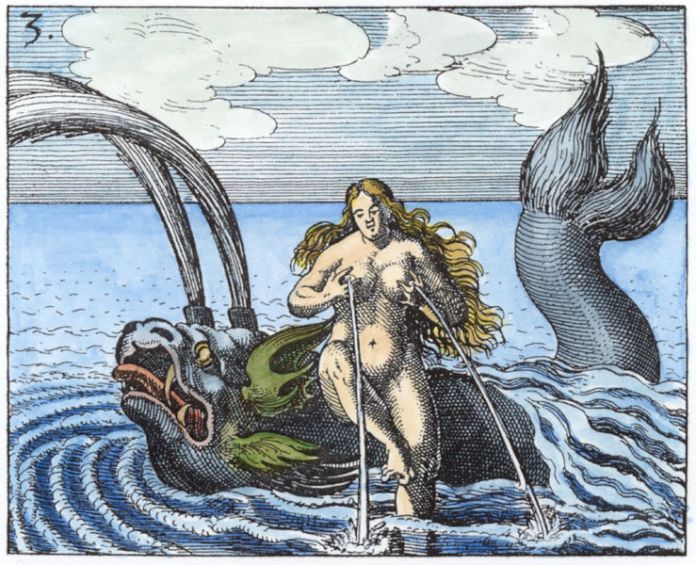
J.D. Mylius version of Basil Valentine ‘Azoth’ series, Philosophia Reformata, 1622. © Adam McLean 1997-2017 (alchemywebsite.com). Used with permission.
As the female correspondence to male sperm the texts nominate the seed of the woman (semen feminile). Among Tantrics it is highly contested whether this is a matter of the menstrual blood or fluids which the mudra [young virgin female] secretes during the sexual act. In any case, the sexual fluids of the man are always associated with the color white, and those of the woman with red. Fundamentally, the female discharge is assigned an equally powerful magic effect as that of its male counterpart. Even the gods thirst after it and revere the menses as the nectar of “immortality”.[134]
Outside of the gynocentric and tantric cults however, a negative valuation of menstrual blood predominates [..] This idea is also widely distributed in Hinayana Buddhism. Menstrual blood is seen there as a curse which has its origins in a female original sin: “Because they are born as women,” it says in a text of the “low vehicle”, “their endeavors toward Buddhahood are little developed, while their lasciviousness and bad characteristics preponderate. These sins, which strengthen one another, assume the form of menstrual blood which is discharged every month in two streams, in that it soils not just the god of the earth but also all the other deities too”. But the Tantrics are completely different! For them the fluids of the woman bear Lucullan names like “wine”, “honey”, “nectar”, and a secret is hidden within them which can lead the yogi to enlightenment.[135]

Trimondi, The Shadow of the Dalai Lama: Sexuality, Magic, and Politics in Tibetan Buddhism (2003).
According to the tantric logic of inversion, that precisely the worst is the most appropriate starting substance for the best, the yogi need not fear the magical destructive force of the menses, as he can reverse it into its creative opposite through the proper method.[136]

Pyramid of lions, Andreas Libavius, Alchymia, Frankfurt 1606. © Adam McLean 1997-2017 (alchemywebsite.com). Used with permission.
Thousands of years before the medieval Tantrics, we find another remarkable parallel in the ancient mythology of Inanna.
In the tale of Inanna and Šu-kale-tuda, having gone up into the mountains on a quest to “detect falsehood and justice, to inspect the Land closely, to identify the criminal against the just”[137] – in other words, to learn to discern the difference between the moral opposites of right and wrong – Inanna is violated by a callow youth while sleeping under a tree. On waking and discovering the offense, the enraged goddess asks “What should be destroyed?”, and floods the Sumerian water supply with “her” menstrual blood:
[E]very woman knows that she has two kinds of flow that come from her vagina. Ancient sources called these the River of Life and the River of Death, meaning the clear or white flow at the time when a child is more likely to be conceived; and the forbidden flow of menstruation, when it is most unlikely that a child can be conceived.[138]
Similarly, in the tale of the Exodus we are told that the first of the ten biblical plagues invoked by Moses magically transformed the Egyptian water supply into blood. In the river Nile – source of life for the Egyptians – all the fish died, and the river became foul smelling, when Aaron (Moses’ brother) touched the water with the “rod of God”.[139]
The second plague?
The magical invocation of frogs: another classic alchemical symbol of the prima materia or base matter – the “evil” fundamental feminine, containing the secret birth-force.[140]

Michael Maier, Atalanta Fugiens: Emblemata Nova de Secretis Naturae Chymica, 1618. © Adam McLean 1997-2017 (alchemywebsite.com). Used with permission.
It should not surprise us to discover that the biblical “Moses” is revered as a great alchemist in both ancient and not-so-ancient texts.
According to the Encyclopedia Judaica:
The Jewish association with alchemy dates from ancient times. Zosimos, a fifth-century Greek historian, states that the Jews acquired the secrets of the “sacred craft” of the Egyptians and the knowledge of the “power of gold” which derives from it by dishonest means, and they imparted the knowledge of alchemy to the rest of the world. In ancient Greek manuscripts, which contain lists of writings on alchemy, a number of alchemic and magic writings are attributed to Moses…[141]
The Jewish Encyclopedia (1906) elaborates:
There is [..] scarcely a single important ancient work upon the science which is not directly related to the Jews, with their traditions and their science.
Alchemy had already in the second or third century assumed a mystical and magical character, exemplified in such recipes as appear in the magic papyri. The whole syncretism of the East—Jewish and Egyptian gnosis, Greek mysteries, and Ophite speculations—combined to produce a current of thought which affected every mental production of the age.
Adam and Abraham have in their turn been described as authors of alchemistic treatises, and Moses is repeatedly met with as the author of such works. To Moses are ascribed the Greek treatise known as “Diplosis” (that is, the art of doubling the weight of gold ), and the treatise “The Chemistry of Moses”…[142]
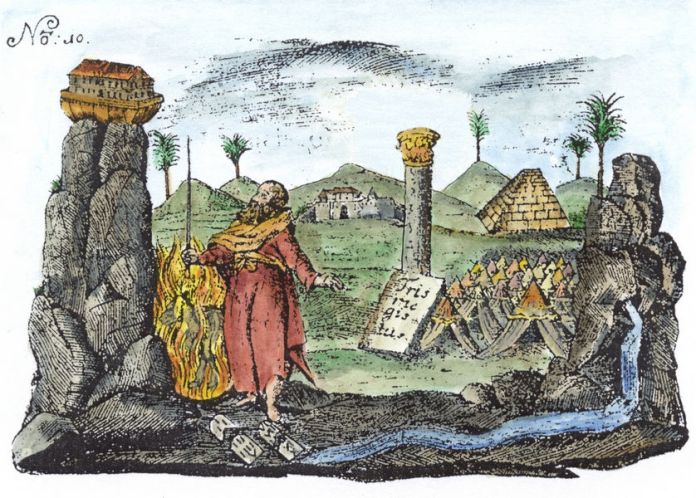
“Trismegistus” (Thrice Greatest – Hermes) – Hans Karl von Ecker, Freymäurerische Versammlungsreden der Gold- und Rosenkreutzer des alten Systems Amsterdam, 1779. © Adam McLean 1997-2017 (alchemywebsite.com)
“Do not touch the philosopher’s stone with your hands;
you are not of our race, you are not of the race of Abraham.”[143]
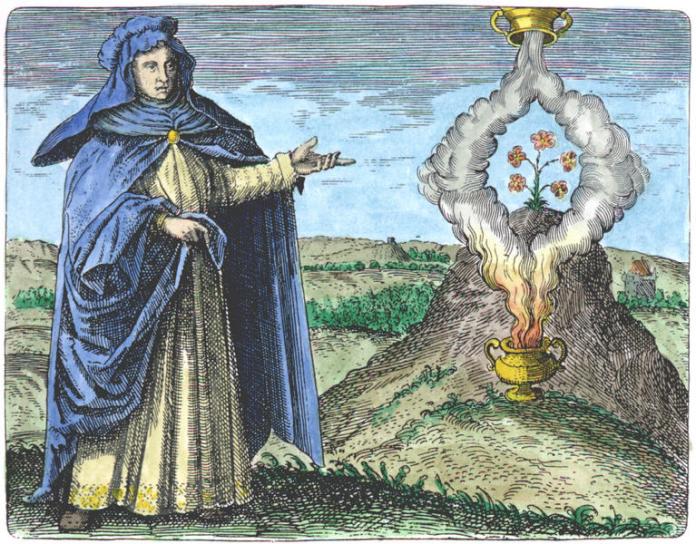
Maria the Jewess, from Michael Maier, Atalanta Fugiens: Emblemata Nova de Secretis Naturae Chymica, 1618. © Adam McLean 1997-2017 (alchemywebsite.com). Used with permission.
Gold and silver
Burnt my Autumns
All too soon
They’d fade and die
And then
Aye, there were no others
Milk and honey
Were their lies
autumnal (adj.) 1570s, “maturing or blooming in autumn;” 1630s, “belonging to autumn,” from Latin autumnalis “pertaining to autumn,” from autumnus (see autumn). From 1650s in figurative sense “past the prime.”[144]
******************
END OF PART II
******************
POSTSCRIPT
Let us summarise then. Consistent with the alchemists’ Babylonian metaphor, your “account” (story) at the bank, is a magic “threshold”, “gate”, or liminal zone.
An orifice.
A rented hole.
Your bank “account” is a metaphor for ‘cock’ hole, rented from a cheating “time god”.
Within a liminal zone – the “source” of all creation – all opposites are equal. They are “unified”. They become one and the same thing.
Within a liminal zone, any one idea, any one word (the “Word” of “God”), is “magic” – it has two, simultaneous, precisely opposite meanings.
Confusion (“chaos”) reigns.
In your rented orifice, the banking high priest shows a magic number. It represents – to you – either a positive (credit), or negative (debit) “balance”.
It represents the opposite to the banking high priest.
Every time that you make a “payment” to someone, the high priest will reduce the amount of sukra (mixed semen-blood) in the orifice you are renting, and increase the amount of sukra in the orifice they are renting.
Every time that you “receive” a “payment” from someone, the reverse happens.

George Withers, A Collection of Emblems, Ancient and Modern, 1635. © Adam McLean (alchemywebsite.com)
Even if you have no debt owed to any bank or financial institution, metaphorically, as a “customer”, you are still a “whore” of the bank. You are renting an orifice from the bank, for the purpose of ingesting and regurgitating the sukra rented by other people.
In essence then, by participating in the lying cheating time lords’ “money of account” fake “deposit” payments system, you are acting as a “Babylonian whore” for the “Grand Sorcerer” and misogynist thief, Mercury-Hermes.
Let that sink in.
*****************
My thanks to readers who have confirmed and connected more dots, by informing me that multiple languages (eg, Danish, French, Italian, Russian) use their native words for “Actives” and “Passives” as synonyms for “Assets” and “Liabilities”, in their double entry bookkeeping balance sheets.
*****************
FOOTNOTES
[43] Jackson C. Frank, Milk and Honey, Jackson C. Frank (1965). My thanks to visual artist John Stark for bringing this lyric to my attention.
[44] Richard A. Werner, How do banks create money, and why can other firms not do the same? An explanation for the coexistence of lending and deposit-taking (2014)
[45] Ahmad Y. al-Hassan, Arabic Alchemy ‘Ilm al-San’a: Science of the Art; History of Science and Technology in Islam
[46] V. and V. Trimondi, The Shadow of the Dalai Lama: Sexuality, Magic and Politics in Tibetan Buddhism (2003), transl. by Mark Penny; p.102, citing Gebelein, 1991, p. 44.
[47] Edward Thomas Jones, Jones’ English System of Book-Keeping by Single or Double Entry, 1796; cited in Jane Gleeson-White, Double Entry: How The Merchants of Venice Created Modern Finance, 2013 (Kindle)
[48] Cabalistic Dualism, Jewish Encyclopedia 1906 (online), 30 June 2017
[49] Richard Mattessich, Accounting and the Input-Output Principle in the Prehistoric and Ancient World, ABACUS, Vol. 25, No. 2, 1989, p. 81 — “The significance of the input—output principle for double entry accounting is well recognized in the literature. For example; ‘The writer wishes to emphasize the merit that comes from understanding a double entry bookkeeping as an input-output system of data calculating the amount of capital charged’ (Kishi, 1984, p. 359).” (p. 77, fn 7)
[50] ibid., p. 81 — “[R]elatively soon after the emergence of the original envelopes (c. 3200 BC) it was already customary to impress the softer clay surface of those envelopes with the hardened clay tokens before putting them into the receptacle and sealing the
latter. This enabled one to determine at a first glance the content of the envelope while the seal and other markings may have informed about the debtor and other details. . This enabled one to determine at a first glance the content of the envelope while the seal and other markings may have informed about the debtor and other details. There can be little doubt that inserting a token into a receptacle was equivalent to a debit entry in an asset account. Yet there were two other requirements: first, to indicate, on the outside of the clay envelope, the individual items contained in it; and second, to disclose instantaneously the total equity represented by the receptacle. By a lucky stroke these two requirements could be met in a single step: impressing the hardened tokens upon the softer, unburned surface of the clay container. The resulting indentations are mirror pictures and true counter-entries (credit entries) on the equity side of this prehistoric record keeping system.”
[51] Murray, Stuart (2009) The Library: An Illustrated History. New York, NY: Skyhorse Publishing. pp. 3-10; cited in Ashurbanipal, Wikipedia
[52] Joshua J. Mark, Cuneiform, Ancient™ History Encyclopedia (13 July 2017)
[53] Rebus, Wikipedia (21 June 2017)
[54] Rebis, Wikipedia, (21 June 2017)
[55] Richard A. Werner, To a new understanding of the function of the banking sector: the mechanism of productive credit creation and quantitative easing; presentation to the Russian Academy of Sciences, round table “Anti-crisis fiscal policy of the state in the interests of economic development of Russia” (2015). (watch video)
[56] Miroslav Novák, Heritage of Alchemical Cryptography (2013), Il Chimico Italiano 24: 17-24 — “Medieval European alchemists used a disorganized way of coded expressing together with a very complicated system of diverse graphical symbols... The symbols, besides their shorthand role, also serve as a specific cryptographic system, for very often the alchemists tried to conceal the results from the Christian church, avaricious noblemen and possible competitors. [..] The cryptography (or cryptology; from Greek κρυπτός, “hidden, secret”; and γράφειν, “writing”, or λογία, “study”, respectively) is the practice and study of techniques for secure communication in the presence of third parties (called adversaries) (Wikipedia). And these adversaries were the main reason, why alchemists coded their written products.”
[57] Dante’s Inferno, Canto XIV — Wikipedia: “Ring 3: Against God, Art, and Nature: The third round of the seventh circle is a great Plain of Burning Sand scorched by great flakes of flame falling slowly down from the sky, an image derived from the fate of Sodom and Gomorrah (Gen. 19:24.) The Blasphemers (the Violent against God) are stretched supine upon the burning sand, the Sodomites (the Violent against Nature) run in circles, while the Usurers (the Violent against Art, which is the Grandchild of God, as explained in Canto XI) crouch huddled and weeping. Ciardi writes, ‘Blasphemy, sodomy, and usury are all unnatural and sterile actions: thus the unbearing desert is the eternity of these sinners; and thus the rain, which in nature should be fertile and cool, descends as fire’ (John Ciardi, Inferno, Canto XIV, pg. 112).”
[58] E. Michael Jones, Barren Metal: A History of Capitalism As The Conflict Between Labor And Usury, 2014
[59] Jolyon Jenkins, How Men In Grey Suits Changed The World, 2010
[60] Geoffrey A. Lee, The Coming of Age of Double Entry: The Giovanni Farolfi Ledger of 1299-1300, The Accounting Historians Journal, Fall 1977 Volume 4, Number 2 —
“Francesco di Marco Datini in late 14th century Italy opened a new ledger with the dedication: ‘in the name of God and of the Virgin Mary and all the Saints of Paradise, that they may give us grace to do right both for body and soul.’
His factor, Monte d’Andrea, followed this with the ten commandments – ‘not always to be observed, perhaps – but there at the head of the ledger they stood.'” — (cit. Origo, Iris, The Merchant of Prato: Francesco Di Marco Datini, Penguin Books, Alfred A. Knopf, Inc., 1963, p. 279)
[61] Jane Gleeson-White, Double Entry: How The Merchants of Venice Created Modern Finance, 2013 (Kindle)
[62] Seth L. Sanders, The First Tour of Hell: From Neo-Assyrian Propaganda to Early Jewish Revelation (Brill, 2009), Journal of Ancient Near Eastern Religions, Volume 9, Issue 2, pp. 151-169 — “As a forerunner of the apocalyptic otherworldly journey and the visionary tour of hell, its lineage includes the books of Enoch, the Revelation of John, and Dante’s Inferno.”
[64] ibid., p.156 — “[The vision] switches without warning into a first-person confession, and in an exquisite narratological twist, the story itself becomes its narrator’s expiation for the sin that the vision condemns.”
[65] ibid., p. 160 — After the prince awakes from his “vision”, the story changes focus to a character called “that scribe”, who is portrayed as “a double of the crown prince: like the prince a sinner who occupies the post of his father”. It is also noteworthy that the narrator of the vision self-identifies as a scribe (p. 162).
[66] ibid., p.161 — On observing the prince’s actions, “that scribe” also takes the King of the Underworld’s warning to heart: “[the scribe] went and repeated [the story] to the palace, saying ‘Let this be my expiation.’”
[67] What Does “Box and Dice” Mean?, WiseGeek, (17 July 2017) — “‘Box and dice’ is an idiomatic English expression, most common in Australian English, which means ‘the whole thing.’ It is usually part of a longer phrase, most commonly ‘the whole box and dice.” The expression is one of a number of similar terms called merisms.
The phrase ‘the whole box and dice’ probably originates from dice games. In many such games, players store the dice in a small box or cup, often made of wood or leather, when not in use. In some games, the box or cup actually forms part of play. For example, in the game ‘liar’s dice,’ players cover their dice with a box to conceal the value of the score they have rolled.
In games of this type, the box and dice are the only pieces of equipment required to play. To have them is therefore to have everything necessary for the game. This is the most likely origin for the use of this expression as a term for “the whole thing.”
[68] ibid., p.157 — “The prince’s sequence of actions has mythic and ritual connotations, albeit ones we do not fully understand. Certainly, the reference to descent to the netherworld evokes a long tradition in both myth and exorcistic ritual of journeys to the realm of the dead, since both Ishtar and terminally ill patients are said to ‘set their mind to going down to the netherworld.’ This suggests that Kummay [titular name of the “crown prince”] is attempting to deliberately induce a vision or even travel to the netherworld of his own volition.”
[69] ibid., p. 158 — “While a šuttu is simply a dream, tabrītu appears frequently in the vocabulary of Sennacherib and Essarhaddon to describe building projects—actually existing physical objects. It refers to awe-inspiring things seen with the eye. Far from a strictly mental event, numerous Sargonid occurrences of tabrītu refer to material things seen in daylight. The way this vision is narrated emphasizes its reality.”
[71] The “gods and demons” are described by various scholars as “hybrid monsters” (Collins 1990) and “monster-demons” (Kvanvig 1981) – that is, they combine animal-bird or human-animal features. Most of the monsters have “feet like a man” (Kvanvig 1981). About one it is said that “with its left foot it was treading” (Kvanvig 1981). One is lacking its hind leg; it will walk with a limp. The last monster is composed of two bodies, has “the head of a man” on the second body, and wears a crown (Kvanvig 1981).
[72] Seth L. Sanders, The First Tour of Hell: From Neo-Assyrian Propaganda to Early Jewish Revelation (Brill, 2009), Journal of Ancient Near Eastern Religions, Volume 9, Issue 2, p. 158
[73] Helge S. Kvanvig, An Akkadian vision as background for Dan 7? (1981), Studia Theologica – Nordic Journal of Theology, 35:1, 85-89
[74] Seth L. Sanders, The First Tour of Hell: From Neo-Assyrian Propaganda to Early Jewish Revelation (Brill, 2009), Journal of Ancient Near Eastern Religions, Volume 9, Issue 2, p. 160
[75] John J. Collins, Review of Roots of Apocalyptic: The Mesopotamian Background of the Enoch Figure and of the Son of Man by Helge S. Kvanvig; Journal of Biblical Literature, Vol. 109, No. 4 (Winter, 1990), p. 717
[76] Seth. L. Sanders, The First Tour of Hell: From Neo-Assyrian Propaganda to Early Jewish Revelation (Brill, 2009), Journal of Ancient Near Eastern Religions, Volume 9, Issue 2, p. 158
[77] John J. Collins, Review of Roots of Apocalyptic: The Mesopotamian Background of the Enoch Figure and of the Son of Man by Helge S. Kvanvig; Journal of Biblical Literature, Vol. 109, No. 4 (Winter, 1990), p. 716
[78] Donald A. Mackenzie, Myths of Babylonia and Assyria (1915), p. 74 (via Sacred Texts, 17 July 2017) — “Another Sumerian storm demon was the Zu bird, which is represented among the stars by Pegasus and Taurus. A legend relates that this ‘worker of evil, who raised the head of evil’, once aspired to rule the gods, and stole from Bel, ‘the lord’ of deities, the Tablets of Destiny, which gave him his power over the Universe as controller of the fates of all. The Zu bird escaped with the Tablets and found shelter on its mountain top in Arabia. Anu called on Ramman, the thunderer, to attack the Zu bird, but he was afraid; other gods appear to have shrunk from the conflict. How the rebel was overcome is not certain, because the legend survives in fragmentary form.”
[79] Seth. L. Sanders, The First Tour of Hell: From Neo-Assyrian Propaganda to Early Jewish Revelation (Brill, 2009), Journal of Ancient Near Eastern Religions, Volume 9, Issue 2, p. 159 — “The vision culminates in a theophany of Nergal, the king of the underworld, enthroned. Kummay quivers in terror at his splendor and falls to his knees before the god. Nergal siezes him by the forelock [..] and roars, intending to kill him, but his advisor Ishum instead advises him to spare Kummay, that he may return penitent to the upper world to begin the glorification of Nergal that results in the story we now read.”
[80] ibid., p.164, citing L4 I. 13 (Streck Assurbanipal: 254), with the variant published by E. Weissert and H.-U. Onasch “The Prologue to Assurbanipal’s Prism E” Or 61 (1992):71.
[81] ibid., p. 165, cf. Dialogue Between Assurbanipal and Nabû — “Of further interest for the identification of the circle in which this text originated is the string of stereotyped wisdom epithets that describe Sennacherib: ‘the eminent one, experienced in matters, wide of understanding, comprehensive in the seat of ordaining fate, who scanned the plans of the foundation of the earth’ (r. 66 uurāti ša markās qaqqari īru).”
[82] 2 Kings 18-19:36, Tanakh, Jerusalem Publication Society (1917)
[83] Temple, Masonic Dictionary (13 July 2017)
[84] Sennacherib, Wikipedia, citing Von Solden (1994) p. 58,100; Foster & Foster (2009) p. 121-123; Stephanie Dalley (2013) The Mystery of the Hanging Garden of Babylon: an elusive world Wonder traced, OUP — “..his building projects included the beautification of Nineveh, a canal 50 km long to bring water to the city, and the ‘Palace Without Rival’, which included what may have been the prototype of the legendary Hanging Gardens of Babylon, or even the actual Hanging Gardens.”
[85] Seth. L. Sanders, The First Tour of Hell: From Neo-Assyrian Propaganda to Early Jewish Revelation (Brill, 2009), Journal of Ancient Near Eastern Religions, Volume 9, Issue 2, p. 160 — “The specific historical identification with Sennacherib is made clear when Nergal says that he built the Akitu house, an act uniquely identified with Sennacherib in this period.”
[86] Joshua J. Mark, Sennacherib, Ancient™ History Encyclopedia (17 July 2017) — “The Book of II Kings 19:37 states, ‘One day, while [Sennacherib] was worshiping in the temple of his god Nisrok, his sons Adrammelek and Sharezer killed him with the sword, and they escaped to the land of Ararat. And Esarhaddon his son succeeded him as king.’ Assyrian inscriptions also maintain that he was killed by his sons but differ on whether he was stabbed or crushed to death. The historian Stephen Bertman writes, ‘Sennacherib was stabbed to death by an assassin (possibly one of his sons) or, according to another account, was crushed to death by the monumental weight of a winged bull that he just happened to be standing beneath’. Whichever way he died, it is thought that he was killed because of his treatment of Babylon.”
[87] Jewish Holy Scriptures: Halakha/Aggadata/Midrash, Encyclopedia Judaica (17 July 2017)
[88] Seth. L. Sanders, The First Tour of Hell: From Neo-Assyrian Propaganda to Early Jewish Revelation (Brill, 2009), Journal of Ancient Near Eastern Religions, Volume 9, Issue 2, p. 160 — “For Sennacherib’s rebuilding of the Akitu-house at Assur, see OIP 2:135-43.”
[89] Given his connection with the “crown prince” and self-professed scribe Assurbanipal – the grandson of Sennacherib – Nabû is an important figure. According to A Dictionary of Ancient Near Eastern Mythology (G. Leick, Routledge 1991):
“He was first called the ‘scribe and minister of Marduk’, and when the latter was assimilated into the official pantheon as the son of Ea, Nabû in turn became known as the son of Marduk from his wife Sarpanitum. He was also accorded the office of patron of the scribes [..] With his elevation to the ranks of the great gods, Nabû became a cosmic deity, entrusted with the Tablets of Destiny, ‘pronouncing the Fate’ of mankind. The texts equate him with Ninurta [elsewhere thought to be the god sent to take back the Tablets of Destiny from the thieving Anzû storm-bird]. He was also sometimes mentioned as a god of water and the fertility of fields, maybe through his descent from Ea; he also shares the epitheton of ‘god of wisdom’. (Pomponio 1978)”
[90] Andrew George, Exit the “House which Binds Death”: the names of Sennacherib’s Akitu temple and its cella, Nouvelles assyriologiques brèves et utilitaires, 1993 (2 no. 43). pp. 34-35.
[91] Meir Malul, The House Which Binds Death/the Sea, N.A.B.U. Nouvelles Assyriologiques Brèves et Utilitaires, vol. 1993/100, 1993, No. 4, pp. 83-85
[92] Rivkah Harris, Inanna-Ishtar as Paradox and Coincidence of Opposites; History of Religions, Vol. 30, No. 3 (Feb., 1991), pp. 273, 275-276
[93] ibid., p. 276-277 — “The chief participants and actors in the goddess’s cult are well known by name [..] Their transvestism simulated the androgyny of Inanna-Ishtar. It was perhaps the inversion of the male/female binary opposition that thereby neutralized this opposition. By emulating their goddess who was both female and male, they shattered the boundary between the sexes. [..] The cultic personnel of the goddess in their costumes, words, and acts had but one goal: ‘to delight Ishtar’s heart, give themselves up to (otherwise) for[bidden] actions.'”
[96] Rebecca Lesses, Lilith, Jewish Women’s Archive, citing Montgomery (117). (3 July 2017)
[97] V. and V. Trimondi, The Shadow of the Dalai Lama: Sexuality, Magic and Politics in Tibetan Buddhism (2003), transl. by Mark Penny; p. 60
[98] Antiquity of the Cabala, Jewish Encyclopedia 1906 (online), 30 June 2017
[99] Rachel Elior, The Paradoxical Ascent to God – The Kabbalistic Theosophy of Habad Hasidim (1992), pp. 217-218 — “‘Before Him, blessed be He, for He is omnipotent, Yesh and Ayin are equated with each other, for before Him, blessed be He, heaven and earth are called one, and Yesh and Ayin are entirely equal to each other’ (Rabbi Aharon Halevi, ‘Avodat ha-Levi, I, p. 1)”
“[..] the Habad teachers posited the vital importance of the equalization of the opposites in human worship. The quality of the equalization of opposites that characterizes God deprives contradictions of all validity. Likewise it permits Him to possess dual and contradictory wills that are susceptible to being equalized and unified from the divine point of view. Thus, a divine paradigm is transformed into a pattern for human worship, which also equalizes between nether and upper worlds by descent and ascent, unifying sanctity and sin, commandment and transgression, divine manifestation and inversion.”
“‘Worship in inversion,’ ‘descent for the purpose of rising up,’ ‘self-prostration,’ and ‘sacrifice of the soul’ were seen to be theurgical missions based on the conflict of fulfilling the reverse of the divine commandment for the sake of the divine will to be revealed in all dimensions. [..] This form of worship is the radical conclusion of the view of divinity as the unity of opposites and the understanding of human vocation as being to equalize the opposites.”
[100] V. and V. Trimondi, The Shadow of the Dalai Lama: Sexuality, Magic and Politics in Tibetan Buddhism (2003), transl. by Mark Penny; p. 75
[101] V. and V. Trimondi, The Shadow of the Dalai Lama: Sexuality, Magic and Politics in Tibetan Buddhism (2003), transl. by Mark Penny, p. 104, p. 103; cf. p. 80; — “The five taboo types of meat are granted a sacramental character. Within them are concentrated the energies of the highest Buddhas, who are able to appear through the ‘law of inversion’. The texts thus speak of the ‘five ambrosias’ or ‘five nectars’. Other impure ‘foods’ have also been assigned to the five Dhyani Buddhas. Ratnasambhava is associated with blood, Amitabha with semen, Amoghasiddhi with human flesh, Aksobhya with urine, Vairocana with excrement (Wayman, 1973, p. 116).”
“The Candamaharosana Tantra lists with relish the particular substances which are offered to the adept by his wisdom consort during the sexual magic rituals and which he must swallow: excrement, urine, saliva, leftovers from between her teeth, lipstick, dish-water, vomit, the wash water which remains after her anus has been cleaned (George, 1974, pp. 73, 78, 79). Those who “make the excrement and urine their food, will be truly happy”, promises the Guhyasamaja Tantra (quoted by Gäng, 1988, p. 134). In the Hevajra Tantra the adept must drink the menstrual blood of his mudra out of a skull bowl (Farrow and Menon, 1992, p. 98). But rotten fish, sewer water, canine feces, corpse fat, the excrement of the dead, sanitary napkins as well as all conceivable “intoxicating drinks” are also consumed (Walker, 1982, pp. 80–84).”
“There exists a strict commandment that the practicing yogi may not feel any disgust in consuming these impure substances. ‘One should never feel disgusted by excrement, urine, semen or blood’ (quoted by Gäng, 1988, p. 266). Fundamentally, ‘he must eat and drink whatever he obtains and he should not hold any notions regarding likes and dislikes’ (Farrow and Menon, 1992, p. 67).”
[103] ibid., p.124 — “In one relevant text can be read: ‘Eve keeps the female seed’ (Jung, 1968, p. 320). Even the retention of sperm and its transmutation into something higher is known in the west. Hence the seventeenth-century doctor from Brussels, Johannes Baptista Helmont, states that, ‘If semen is not emitted, it is changed into a spiritual force that preserves its capacities to reproduce sperm and invigorates breath emitted in speech’ (Couliano, 1987, p. 102). Giordano Bruno, the heretic among the Renaissance philosophers, wrote a comprehensive essay on the manipulation of erotic love through the retention of semen and for the purposes of attaining power.”
[104] ibid., p.104 citing Evola, 1993, p. 207
[105] ibid., citing Bachelard, 1990, p. 282.
[106] ibid., p. 62, citing Gross, 1993, p. 48
[107] ibid., p. 47, citing Shaw, 1994, n. 128, pp. 7, 254–255
[109] ibid, p. 75 — “Suitably radical instructions can be found in the Hevajra Tantra: “A wise man … should remove the filth of his mind by filth … one must rise by that through which one falls”, or, more vividly, “As flatulence is cured by eating beans so that wind may expel wind, as a thorn in the foot can be removed by another thorn, and as a poison can be neutralized by poison, so sin can purge sin” (Walker, 1982, p. 34).”
[112] ibid., p.76 — “The fifth and final argument attempts to persuade us that enlightenment per se arises through the radical inversion of its opposite and that there is absolutely no other possible way to break free of the chains of samsara. Here, the tantric logic of inversion has become a dogma which no longer tolerates other paths to enlightenment.”
“However, this tantric logic of inversion contains a dangerous paradox. On the one hand, Vajrayana stands not just in radical opposition to ‘social’ norms, but likewise also to the original fundamental rules of its own Buddhist system. Thus, it must constantly fear accusations and persecution from its religious brethren. On the other there is the danger mentioned by Friedrich Nietzsche, that anyone who too often looks monsters in the face can themselves become a monster.”
[113] J. Assante, Sex, Magic, And The Liminal Body In The Erotic Art And Texts Of The Old Babylonian Period (2002); Sex and Gender in the Ancient Near East; proceedings of the 47th Rencontre Assyriologique Internationale, 2001, p. 34
[114] Wolkstein D. and Kramer S., The Courtship of Inanna and Dumuzi; Inanna, Queen of Heaven and Earth: Her Stories and Hymns from Sumer (1983), Harper & Row (New York), pp. 38-39, 48 — “These Sumerian love songs between the shepherd-king and Inanna belonged in Sumerian times to a ritual Sumerologists call the sacred marriage rite. In this ritual, the king of a Sumerian city (usually given the epithet ‘Dumuzi’) symbolically weds the goddess Inanna, who is represented by the high priestess of her city. If the goddess is pleased with her suitor and his gifts, she opens her house to him. The sacred marriage bed is prepared, and there, at the proper time (see ‘The Joy of Sumer’ hymn and commentary), the marriage between king and goddess takes place to the accompaniment of merriment and such songs as those in ‘The Courtship.'” (Kramer, p. 154)
“The ‘always’ ends. Whether by external or internal interference, unending, uninterrupted mutual bliss is not an earthly possibility. Change is the human condition. In this instance, it is the woman Inanna who by calling for the royal marriage bed brings the family and social world into her exclusive relationship with Dumuzi, thus ending ‘the honey-moon.'” (Kramer, p. 153)
[115] V. and V. Trimondi, The Shadow of the Dalai Lama: Sexuality, Magic and Politics in Tibetan Buddhism (2003), transl. by Mark Penny, p. 91-92, 271
[116] A. Leo Oppenheim, Ancient Mesopotamia, (University of Chicago Press, 1977 ed), p. 204
[117] Mukīl rēš lemutti, Wikipedia, citing F.A. Wiggermann (1997) “Mischwesen, A”. in D.O. Edzard. Reallexikon der Assyriologie und Vorderasiatischen Archäologie: Meek – Mythologie. Walter De Gruyter, p. 241 ; and Jo Ann Scurlock, Burton R. Andersen (2005), Diagnoses in Assyrian and Babylonian Medicine: Ancient Sources, Translations, and Modern Medical Analyses. University of Illinois Press, p. 246
[118] Jo Ann Scurlock (2006), Magico-Medical Means of Treating Ghost-Induced Illnesses in Ancient Mesopotamia. Brill, pp. 30, 53
[119] J. Assante, Sex, Magic, And The Liminal Body In The Erotic Art And Texts Of The Old Babylonian Period (2002); Sex and Gender in the Ancient Near East; proceedings of the 47th Rencontre Assyriologique Internationale, 2001, pp. 28-30
[120] Ecclesiastes 11:1-2 (Amplified Bible)
[121] Marriage of the Sea ceremony, Wikipedia, citing Kennedy, Benjamin (1962). “35b”. Revised Latin Primer. Great Britain: Longmans. p. 19; The Bucintoro, Comitato Festa della Sensa (17 Feb 2012). (21 June 2017)
[122] J. Assante, Sex, Magic, And The Liminal Body In The Erotic Art And Texts Of The Old Babylonian Period (2002); Sex and Gender in the Ancient Near East; proceedings of the 47th Rencontre Assyriologique Internationale, 2001 — The traditional scholarly view is that harimtu means prostitute, and refers to a cult of “sacred prostitution”. This view has been challenged by feminist scholars such as Assante (1998, 2000: 10-73), arguing for an interpretation of the harimtu as an unmarried/unattached woman looking for sex, in a culture that had a libertine (my word) view to sexual activity.
[123] Michael Hudson and Marc Van De Mieroop, Debt and Economic Renewal in the Ancient Near East, pp. 23-35
[124] Alexander Solzhenitsyn, Two Hundred Years Together, chapter 3. See also the “Jewish Regulation of 1804”, which included a total prohibition on Jewish distilling and tavern keeping.
[125] Michael Homan, Beer Production by Throwing Bread into Water: A New Interpretation of Qoh. XI 1-2, Vetus Testamentum, Vol. 52, Fasc. 2 (Apr., 2002), pp. 275-278 — “Beer and bread were intimately linked in the ancient Near East. Breweries from Egypt to Mesopotamia created beer by lightly baking dough composed of ground germinated cereals, and these loaves along with yeast were placed in jars of water, where the maltose sugars were converted to alcohol.”
“In favor of this interpretation are several Akkadian passages which state that beer ingredients (including bappir bread and dates) are thrown into the water to produce beer, with the verb nadu (“to throw”) used in technical language for brewing beer.”
[126] J. Assante, Sex, Magic, And The Liminal Body In The Erotic Art And Texts Of The Old Babylonian Period (2002); Sex and Gender in the Ancient Near East; proceedings of the 47th Rencontre Assyriologique Internationale, 2001, pp. 33-34 —
“With the slap of the face, with the rolling of the eyes,
I have hit you on the head, I have deranged your reason,
Set your will to my will,
Set your decision to my decision,
I hold you fast as Ishtar held Dumuzi,
(As) beer binds her drinker,
I have bound you with my hairy mouth,
With my vagina (full of) wetness,
With my mouth (full of) saliva,
With my vagina (full of) wetness,
No female rival shall go near you!”
“What is important here is that the incantation employs Ishtar’s seizure of her lover and beer’s seizure of the drinker as similes for the state of being spellbound. [..] Ishtar, beer, vagina and mouth all have the power to bind. Here, as elsewhere, the vagina and mouth are interchangeable. The magical body of the divine harimtu binds at both ends. [..] The association between drinking and sex was deeply rooted in the Mesopotamian psyche of the Old Babylonian period [..] For example, beer was firmly equated to saliva and vaginal wetness [..] Mesopotamian beer was normally sweetened with date syrup, called “honey” in modern translations. In most literary erotica the mouth and vulva are honey-sweet, as they are in this Sumerian court poem from Ur:”
“My god, the tavern keeper, her beer is sweet!
And her vulva is sweet like her beer – and her beer is sweet!
And her vulva is sweet like all her mouths – and her beer is sweet!
Her kašbir-beer and her (regular) beer are sweet.”
“In this hymn, the poet adds the anus to the list of transposable body portals, although it is merely alluded to as inferior kašbir beer.”
[127] Rivkah Harris, Inanna-Ishtar as Paradox and Coincidence of Opposites; History of Religions, Vol. 30, No. 3 (Feb., 1991), p. 273
[128] J. Assante, Sex, Magic, And The Liminal Body In The Erotic Art And Texts Of The Old Babylonian Period (2002); Sex and Gender in the Ancient Near East; proceedings of the 47th Rencontre Assyriologique Internationale, 2001, p. 33
[129] Revue d’Assyriologie et d’archéologie orientale. Given intention to publish a book revealing a host of further evidences, this author apologises for not providing a more detailed citation at this time.
[130] 2 Kings 17:19-24, Ezra 4:9-11, Tanakh, Jewish Publication Society of America, 1917 — 2 Kings 17:19-24
19. Also Judah kept not the commandments of the LORD their God, but walked in the statutes of Israel which they practised.
20. And the LORD rejected all the seed of Israel, and afflicted them, and delivered them into the hand of spoilers, until He had cast them out of His sight.
..
22. And the children of Israel walked in all the sins of Jeroboam which he did; they departed not from them;
23 until the LORD removed Israel out of His sight, as He spoke by the hand of all His servants the prophets. So Israel was carried away out of their own land to Assyria, unto this day.
24 And the king of Assyria brought men from Babylon, and from Cuthah, and from Avva, and from Hamath and Sepharvaim, and placed them in the cities of Samaria instead of the children of Israel; and they possessed Samaria, and dwelt in the cities thereof.
Ezra 4:9-11
9 ..then wrote Rehum the commander, and Shimshai the scribe, and the rest of their companions; the Dinites, and the Apharesattechites, the Tarpelites, the Apharesites, the Archevites, the Babylonians, the Shushanchites, the Dehites, the Elamites,
10 and the rest of the nations whom the great and noble Asenappar brought over, and set in the city of Samaria, and the rest that are in the country beyond the River…
[131] Nili Wazana, Anzu and Ziz: Great Mythical Birds in Ancient Near Eastern, Biblical, and Rabbinic Traditions (2008), Journal of the Ancient Near Eastern Society 31 (2009): 111-135 –– “Were the Israelites acquainted with the Epic of Anzu? A seventh century b.c.e. cylinder seal portraying the battle of Ninurta and Anzu was discovered in Israel. While this sporadic, graphic witness cannot count as proof of knowledge of the Epic of Anzu, it does show that symbols of the combat myth had arrived along with the Assyrian army, part and parcel of a general cultural influence. Furthermore, studies have shown that the Bible employs literary motifs and linguistic expressions reflecting royal Neo-Assyrian inscriptions when ‘quoting’ Assyrian speakers, concluding that some biblical authors must have been acquainted not only with the ‘Assyrian experience,’ but also with official royal literary traditions. Considering that the Epic of Anzu played a role in the language of royal Neo-Assyrian inscriptions, underlying the criminal characterization of some of the figures in imperialistic propaganda, it is highly probable that biblical authors were familiar with this creature and its traditions—even if they did not know the epic itself, before the Babylonian exile.”
[132] Russell Gmirkin, Berossus and Genesis, Manetho and Exodus: Hellenistic Histories and the Date of the Pentateuch, 2006 — Gmirkin offers evidence that contradicts a widely-accepted argument concerning the earliest origins of “anti-Semitism”, which is allegedly found in the writings of an Egyptian priest of the third century BC named Manetho, in his history of Egypt (Aegyptiaca). Manetho reported that centuries earlier, a foreign population had entered Egypt from the east via the Nile delta. These foreigners rose in power, and became an increasing problem to the Egyptian natives, who were finally motivated to expel them when the foreign population developed a serious skin disease (leprosy?). According to Manetho, these ejected foreigners relocated to Jerusalem.
Gmirkin argues that the book of Exodus was written by Jewish intellectuals in Alexandria (Egypt) in reaction to Manetho, whose account came first and was more accurate. That is to say, rather than Manetho attacking the Jews, “the borrowing and polemics took place in the opposite direction; the Pentateuch polemicized against the Egyptian expulsion stories in Manetho.” (pp.2-3)
[133] Exodus 3:8, 33:3, Tanakh, Jerusalem Publication Society, 1917 – the common interpretation has been that “flowing with milk and honey” is a metaphor for the abundant fertility of the land itself.
[134] V. and V. Trimondi, The Shadow of the Dalai Lama: Sexuality, Magic and Politics in Tibetan Buddhism (2003), transl. by Mark Penny, p. 119
[136] ibid., 121 — “The embracing of a ‘bleeding’ lover is therefore a great ritual privilege. In his book on Indian ecstatic cults, Philip Rawson indicates that ‘the most powerful sexual rite … requires intercourse with the female partner when she is menstruating and her “red” sexual energy is at its peak’ (Rawson, 1973, p. 24; see also Chöpel, 1992, p. 191).”
[137] Judy Grahn, Ecology of the Erotic in a Myth of Inanna, International Journal of Transpersonal Studies 29(2), 2010, p. 60; citing Black et al., 2004, p. 197
[138] Lishtar, The Avenging Maiden and the Predator Gardener: A Study of Inanna and Shukaletuda (2000), citing Shuttle and Redgrove (1989), p. 21
[139] Exodus 7:14-24, Tanakh, Jerusalem Publication Society, 1917 – “And the LORD said unto Moses: ‘Say unto Aaron: Take thy rod, and stretch out thy hand over the waters of Egypt, over their rivers, over their streams, and over their pools, and over all their ponds of water, that they may become blood; and there shall be blood throughout all the land of Egypt, both in vessels of wood and in vessels of stone.’” (verse 19)
[140] Exodus 8:26-29; 9:1-10, Tanakh, Jerusalem Publication Society, 1917
[141] Alchemy, Encyclopedia Judaica, Jewish Virtual Library (17 June 2017) — “The Jewish association with alchemy dates from ancient times. Zosimos, a fifth-century Greek historian, states that the Jews acquired the secrets of the “sacred craft” of the Egyptians and the knowledge of the “power of gold” which derives from it by dishonest means, and they imparted the knowledge of alchemy to the rest of the world. In ancient Greek manuscripts, which contain lists of writings on alchemy, a number of alchemic and magic writings are attributed to Moses…”
[142] Alchemy, Jewish Encyclopedia, (17 June 2017) — “Traces of the connection of Jews with the science of Alchemy are very scanty in Hebrew literature. Not a single distinguished adept is found who has left in a Hebrew form traces of his knowledge of the subject. There is, however, scarcely a single important ancient work upon the science which is not directly related to the Jews, with their traditions and their science. Alchemy, like others of the exact sciences, suffered from the introduction of foreign elements, and developed from a more or less secret science belonging to a particular craft, into a mysterious science dealing with changes in the organic as well as the metallic world.”
“In the evolution of Alchemy there are at least three epochs: The first, the Greek and Egyptian period; the second, the Arabic of the Middle Ages; and the last, or modern, period, extending from the sixteenth century to the present day.”
“Alchemy had already in the second or third century assumed a mystical and magical character, exemplified in such recipes as appear in the magic papyri. The whole syncretism of the East—Jewish and Egyptian gnosis, Greek mysteries, and Ophite speculations—combined to produce a current of thought which affected every mental production of the age.”
“Adam and Abraham have in their turn been described as authors of alchemistic treatises, and Moses is repeatedly met with as the author of such works. To Moses are ascribed the Greek treatise known as ‘Diplosis’ (that is, the art of doubling the weight of gold), and the treatise ‘The Chemistry of Moses’ (dealing with metallurgy), published by Berthelot in his ‘Collection des Anciens Alchimistes Grecs,’ Paris, 1887-88, ii. 300-315, iii. 287-301. In the Greek manuscript of St. Mark of the ninth century Zosimos quotes long passages from ‘The Chemistry of Moses.'”
[143] Vladimír Karpenko, Alchemy as donum dei, HYLE – International Journal for Philosophy of Chemistry, Vol. 4 (1998), No. 1, pp. 63-80; — “In the Hellenistic world particular attention should be paid to Mary the Jewess, one of the most influential personalities of this science. God appears in connection with her, but in a slightly different manner than later. To Mary, alchemy is donum dei, a gift of God; but this gift was given only to ‘chosen people’, Jews. She is reported to have said: “Do not touch the philosopher’s stone with your hands; you are not of our race, you are not of the race of Abraham.’* Thus alchemy was not for alchemists in general, but for the race of Abraham. Alchemy is presented here as the spiritual property of Jews. As pointed out by Patai, the singular form ‘God’ is used strictly in texts attributed to Mary, and this claim that alchemical secrets were revealed to her by God became a part of the medieval alchemical tradition about her.”
*Patai, R.: 1994, The Jewish Alchemists, Princeton Univ. Press, Princeton, p. 76.
[144] Autumnal, Online Etymology Dictionary (10 July 2017)
Autumn (n): late 14c., autumpne (modern form from 16c.), from Old French autumpne, automne (13c.), from Latin autumnus (also auctumnus, perhaps influenced by auctus “increase”).
Harvest (n): Old English hærfest “autumn,” as one of the four seasons, “period between August and November,” from Proto-Germanic *harbitas (source also of Old Saxon hervist, Old Frisian and Dutch herfst, German Herbst “autumn,” Old Norse haust “harvest”), from PIE *kerp- “to gather, pluck, harvest” (source also of Sanskrit krpana– “sword,” krpani “shears;” Greek karpos “fruit,” karpizomai “make harvest of;” Latin carpere “to cut, divide, pluck;” Lithuanian kerpu “cut;” Middle Irish cerbaim “cut”).
In Old English with only implied reference to the gathering of crops. The borrowing of autumn and the use of fall (n.) in a seasonal sense gradually focused the meaning of harvest to “the time of gathering crops” (mid-13c.), also to the action itself and the product of the action (after c. 1300), which became its main senses from 14c.








